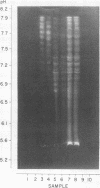Full text
PDF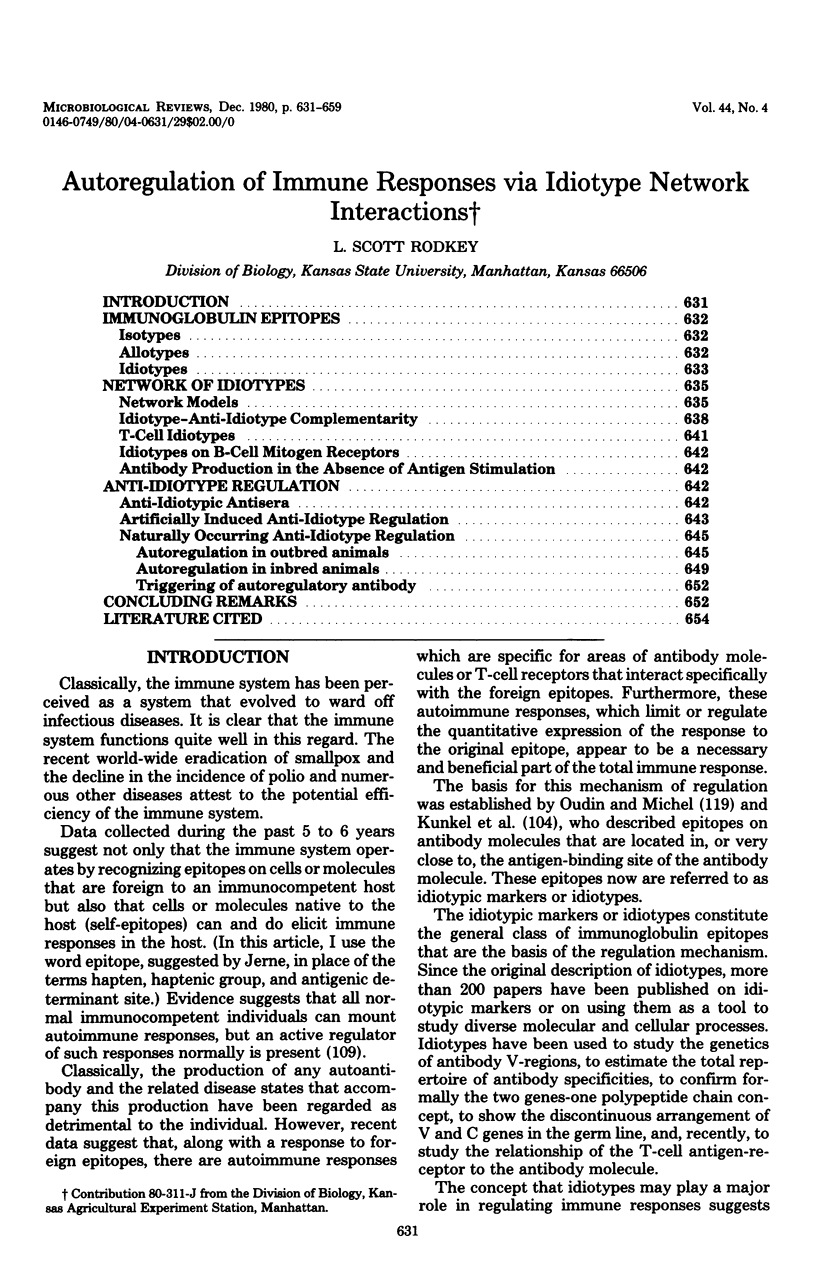
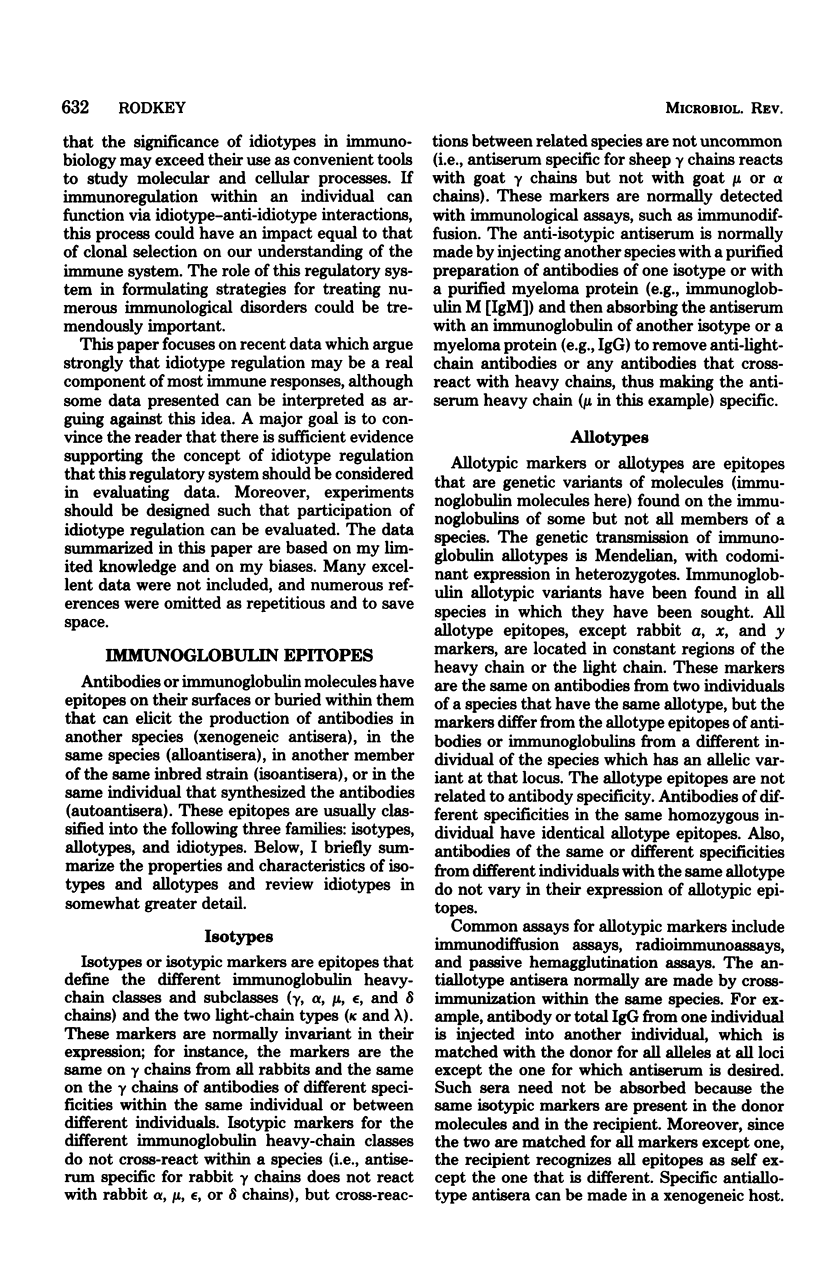

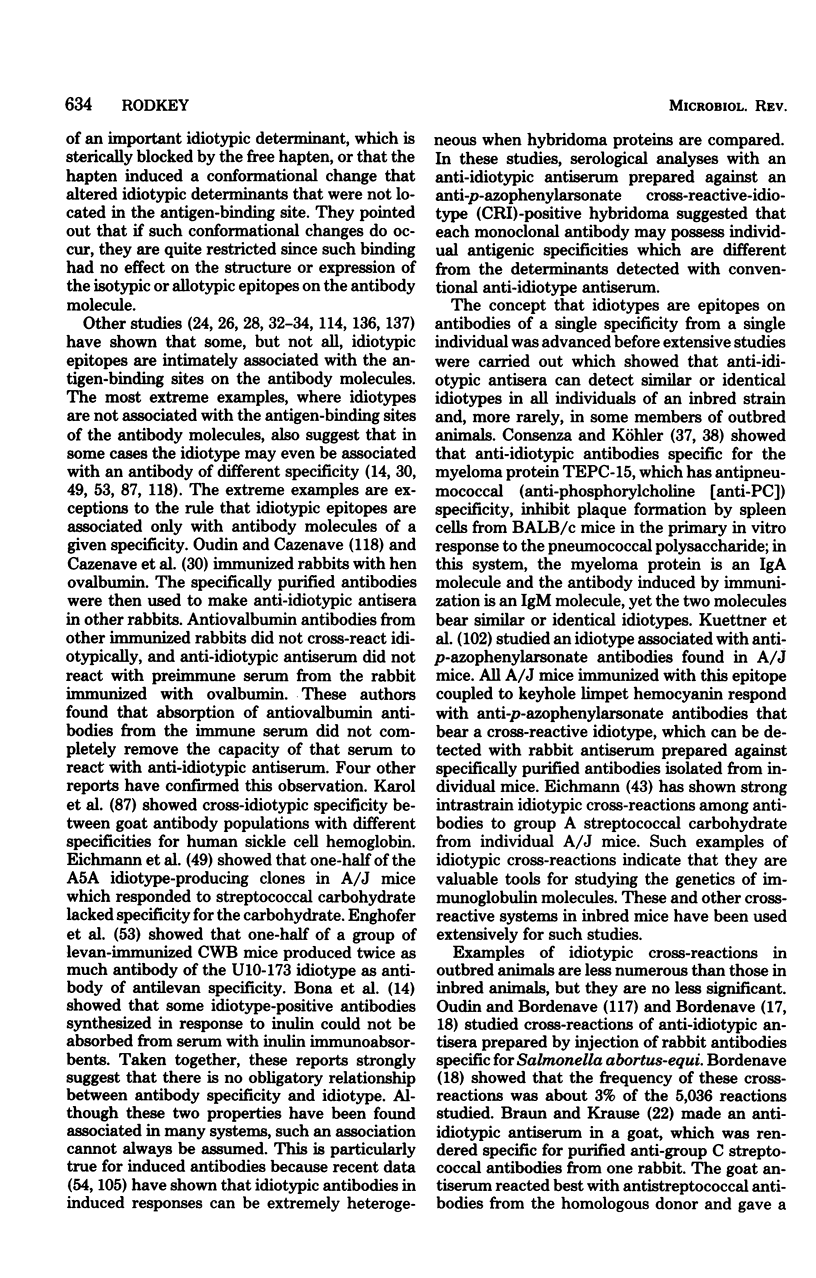
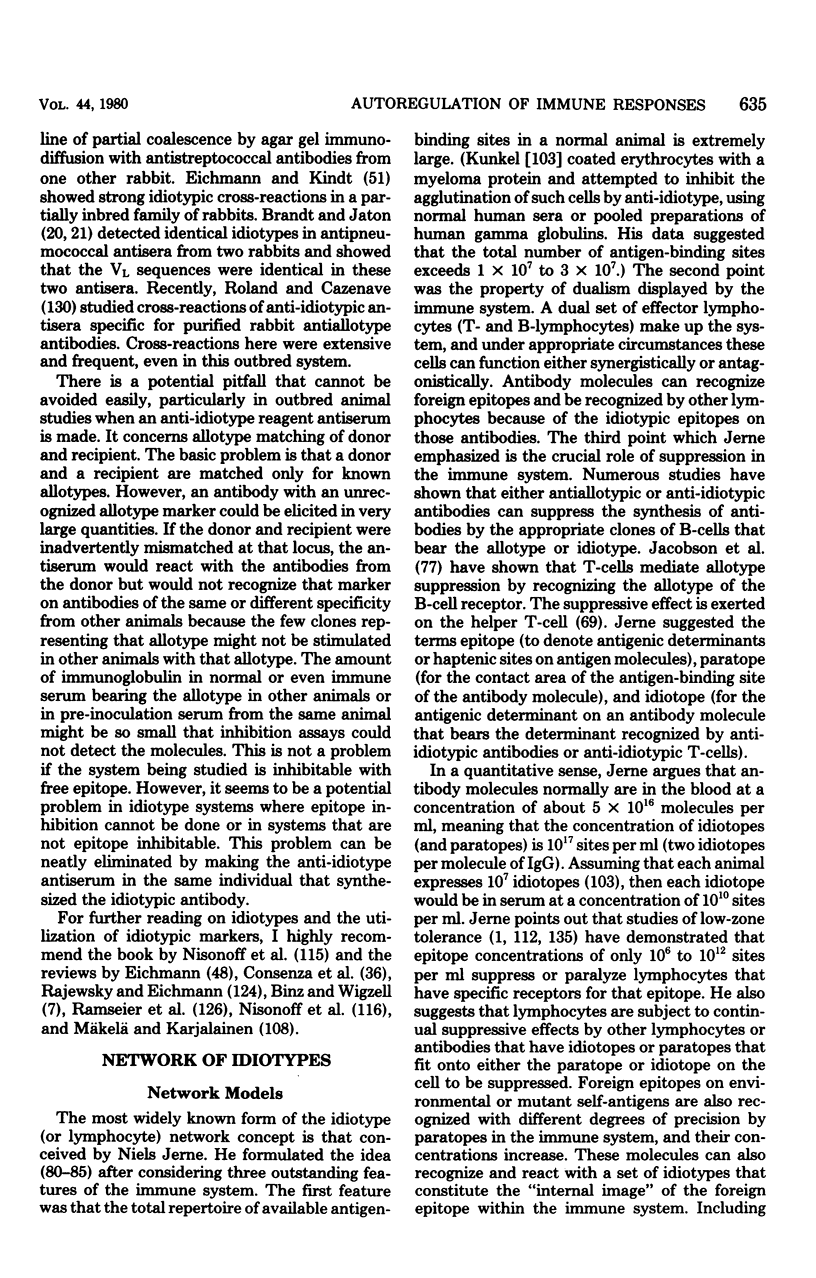
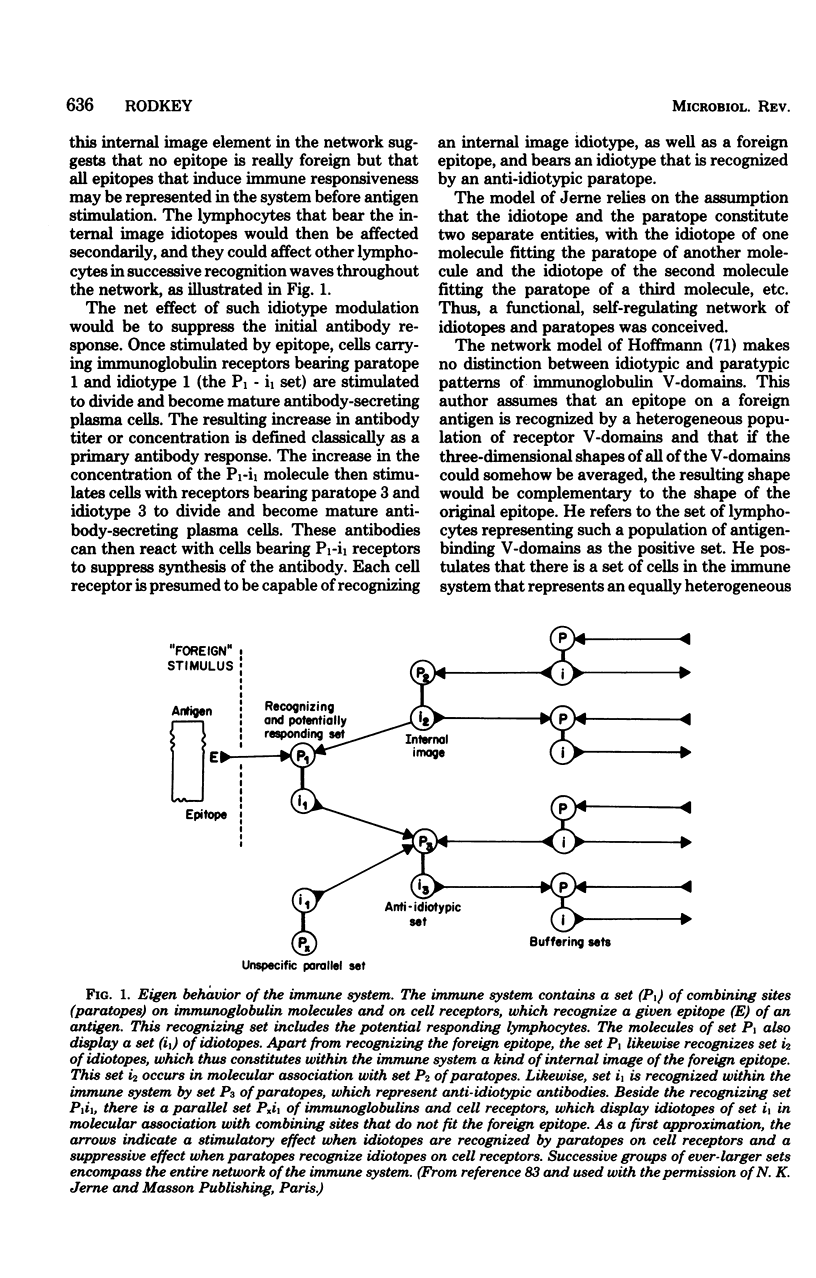
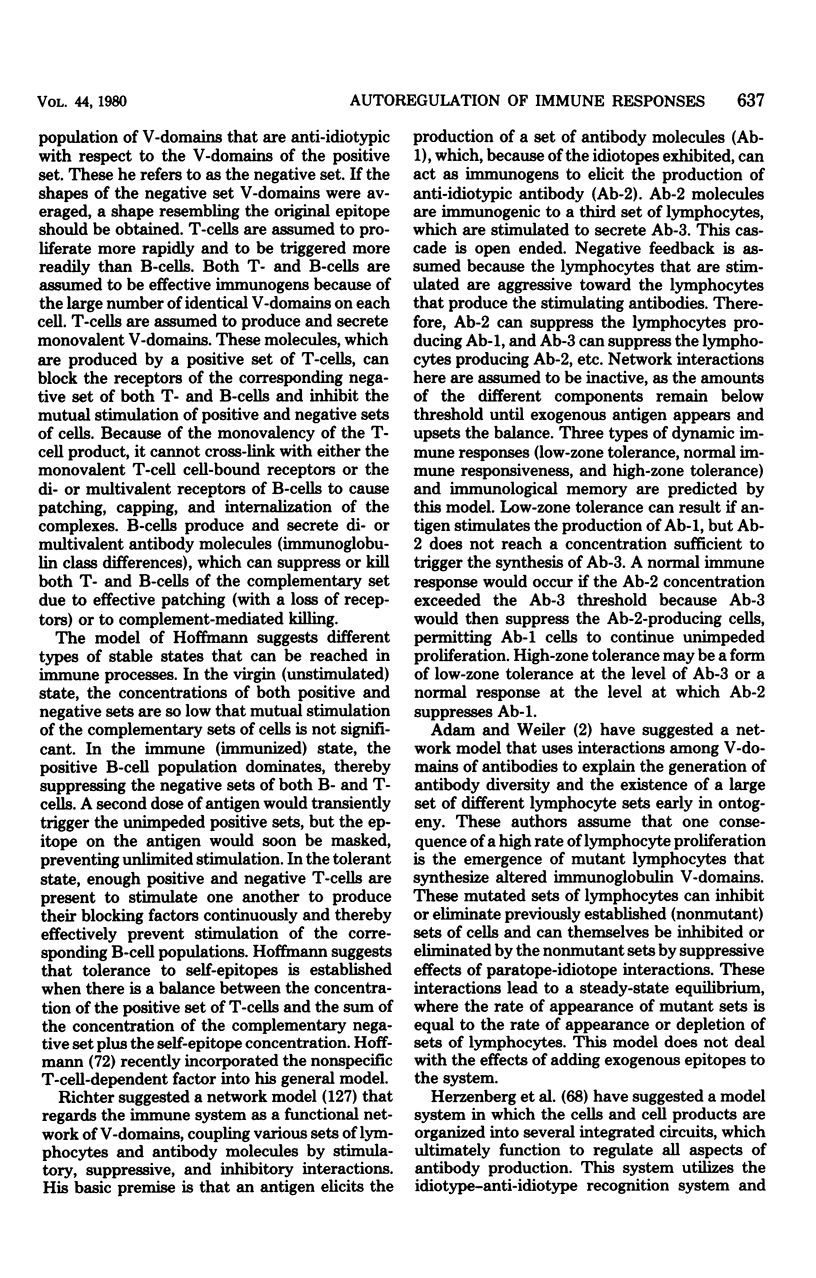
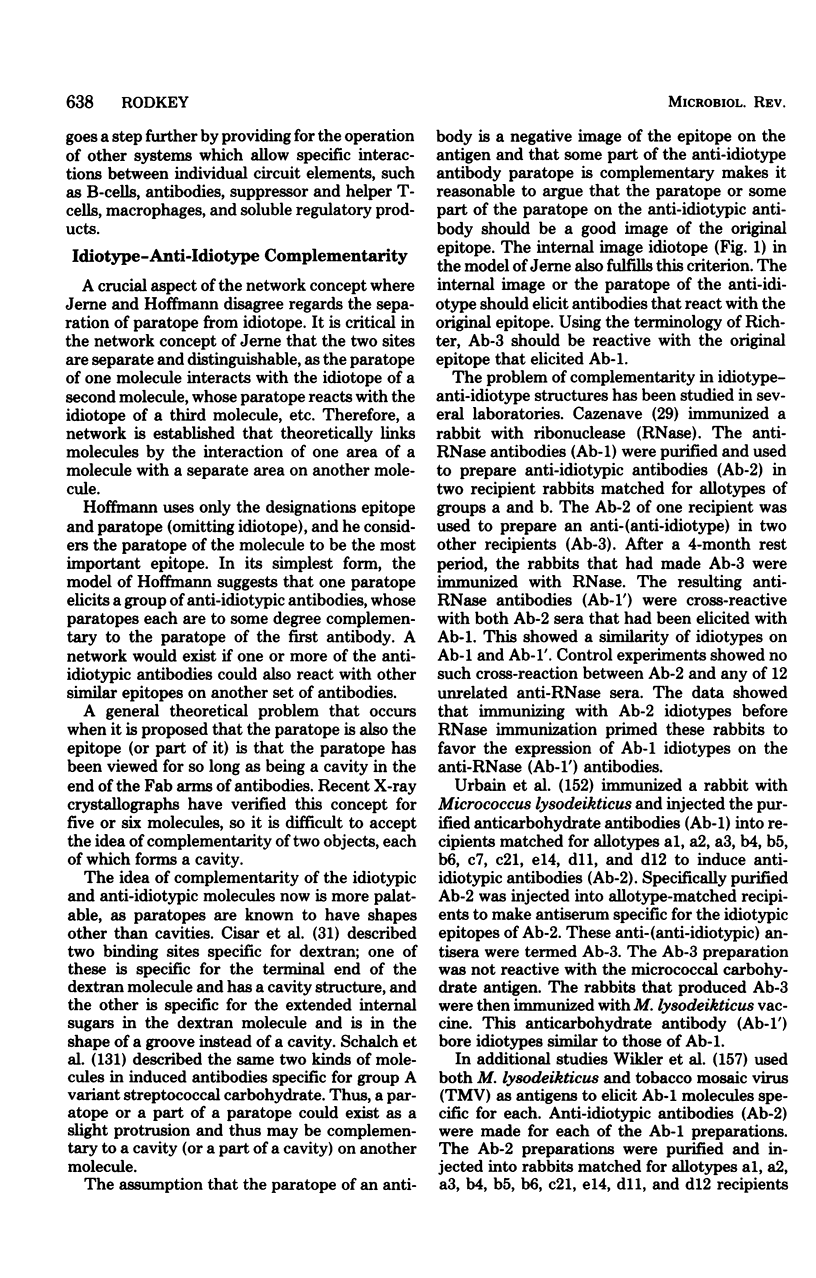
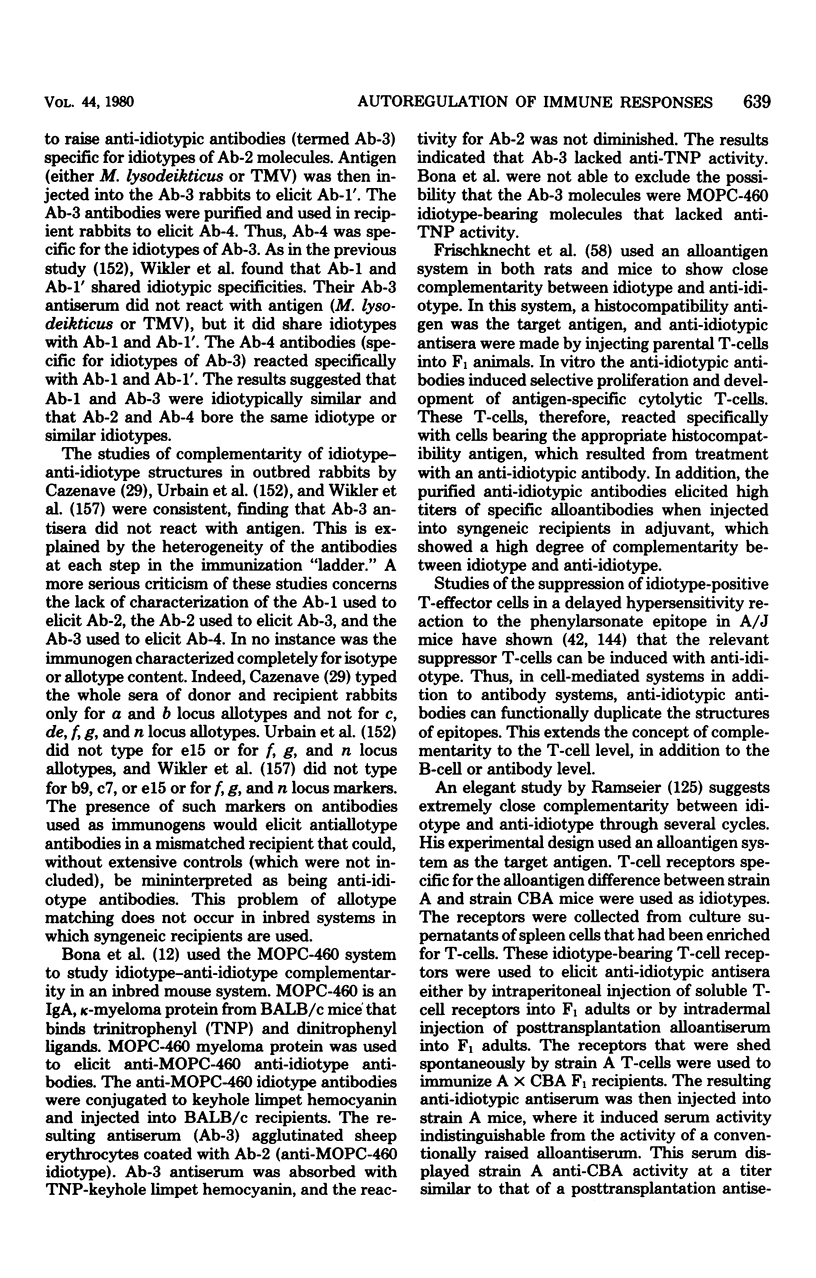

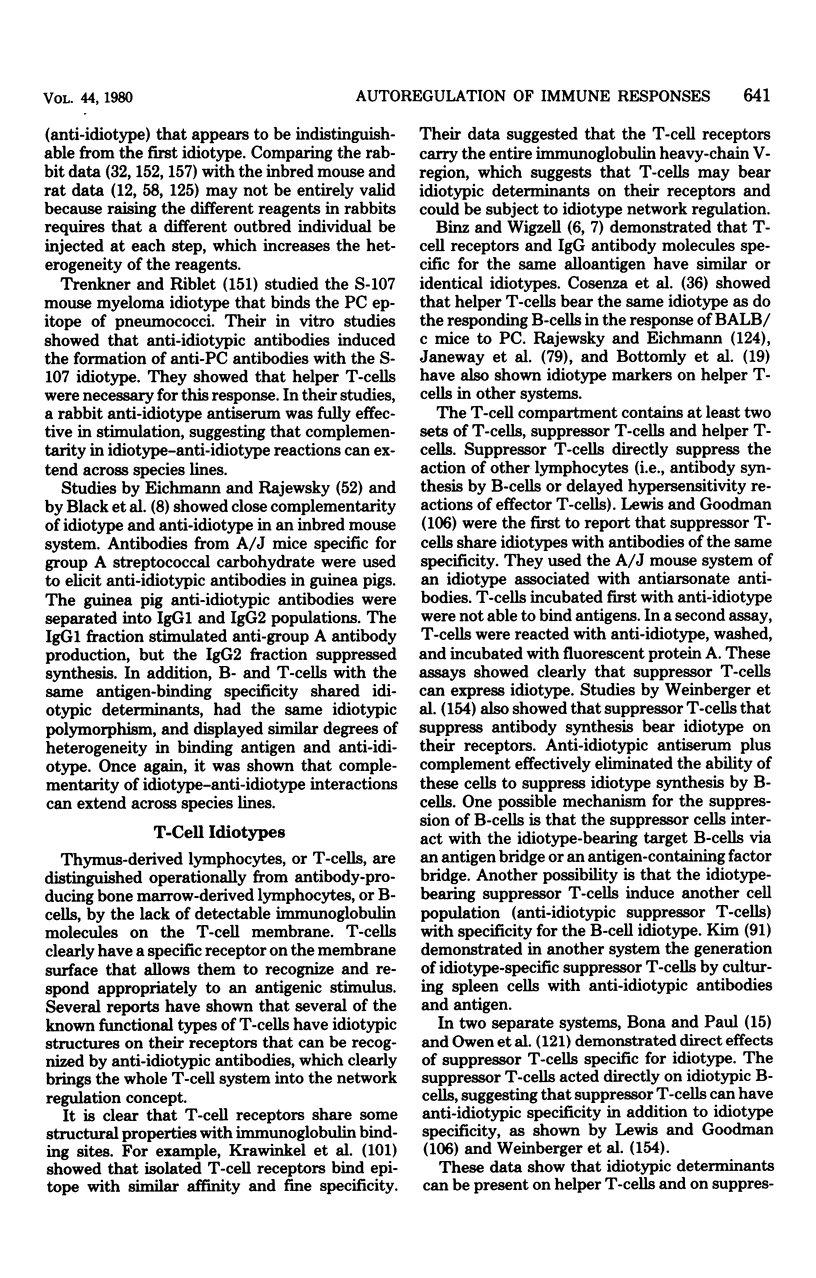
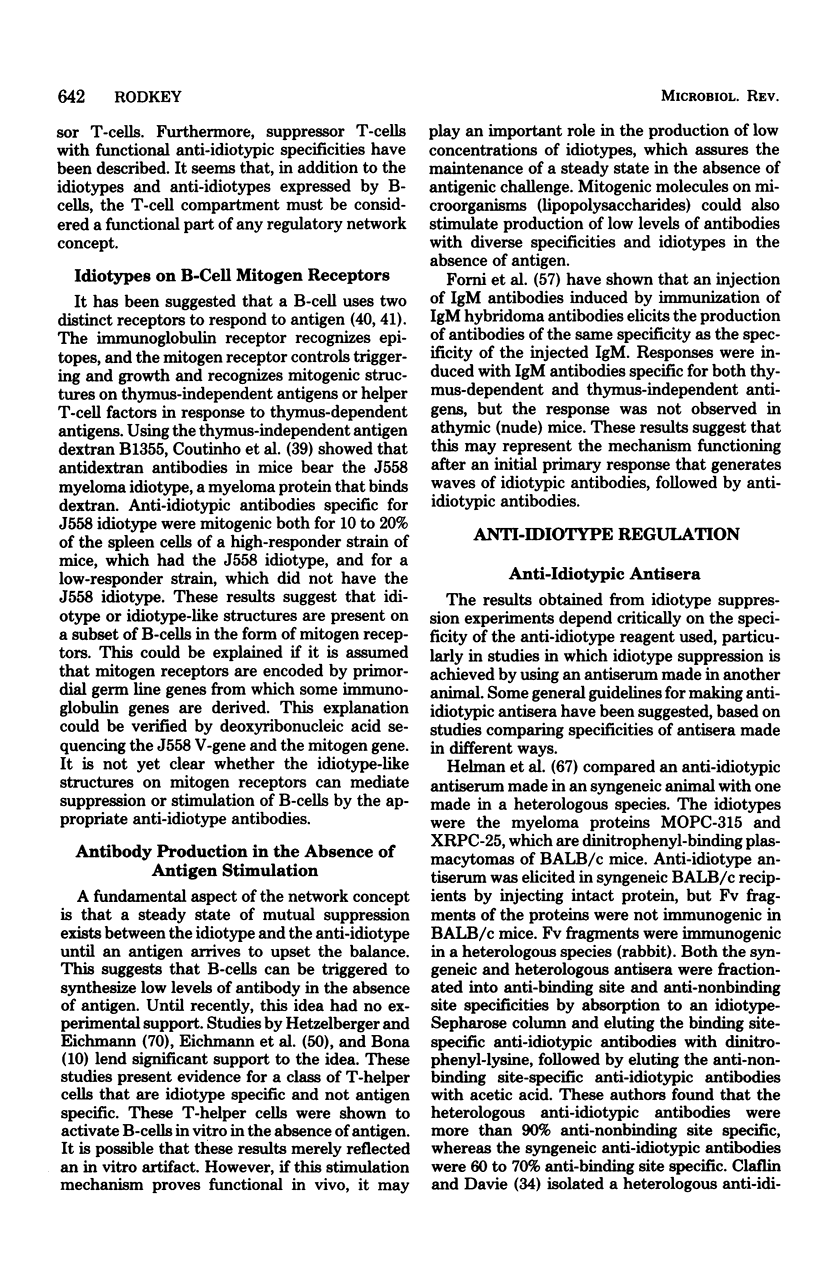

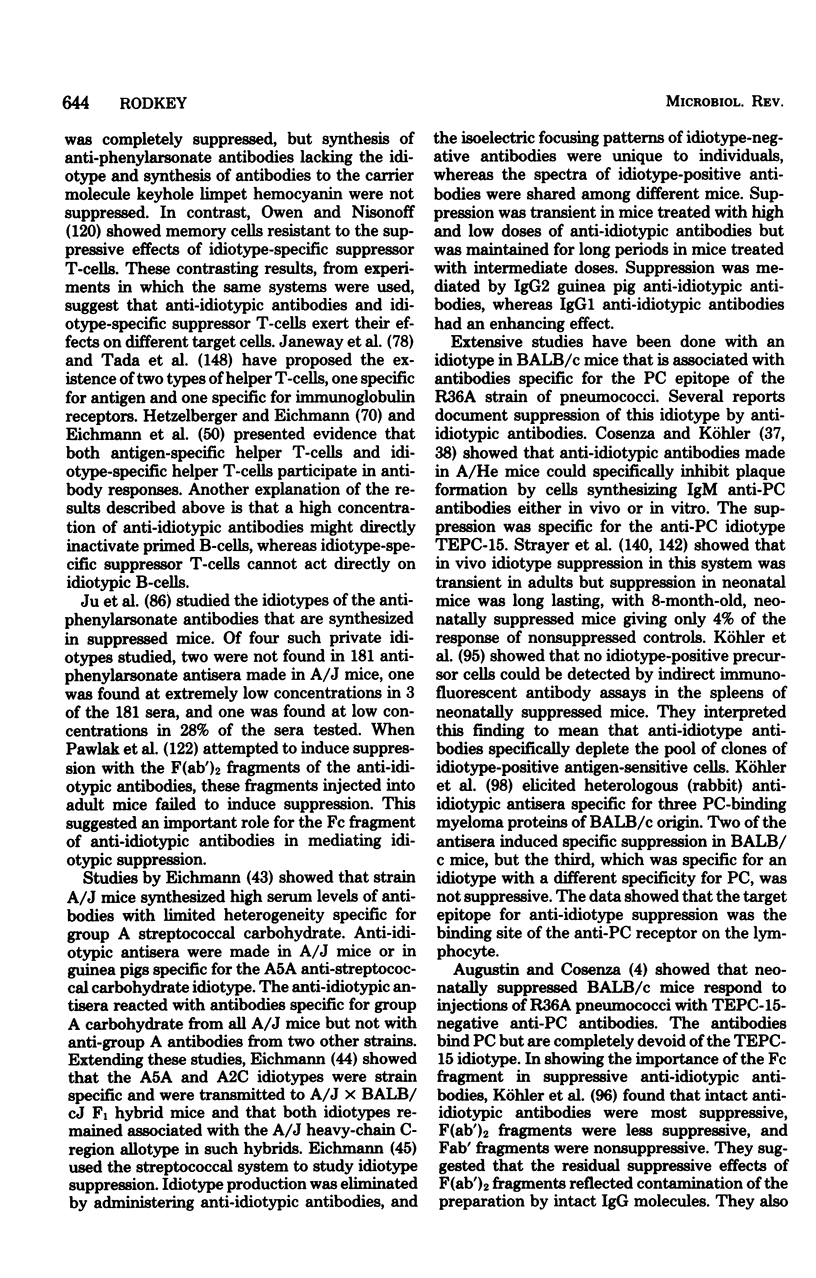
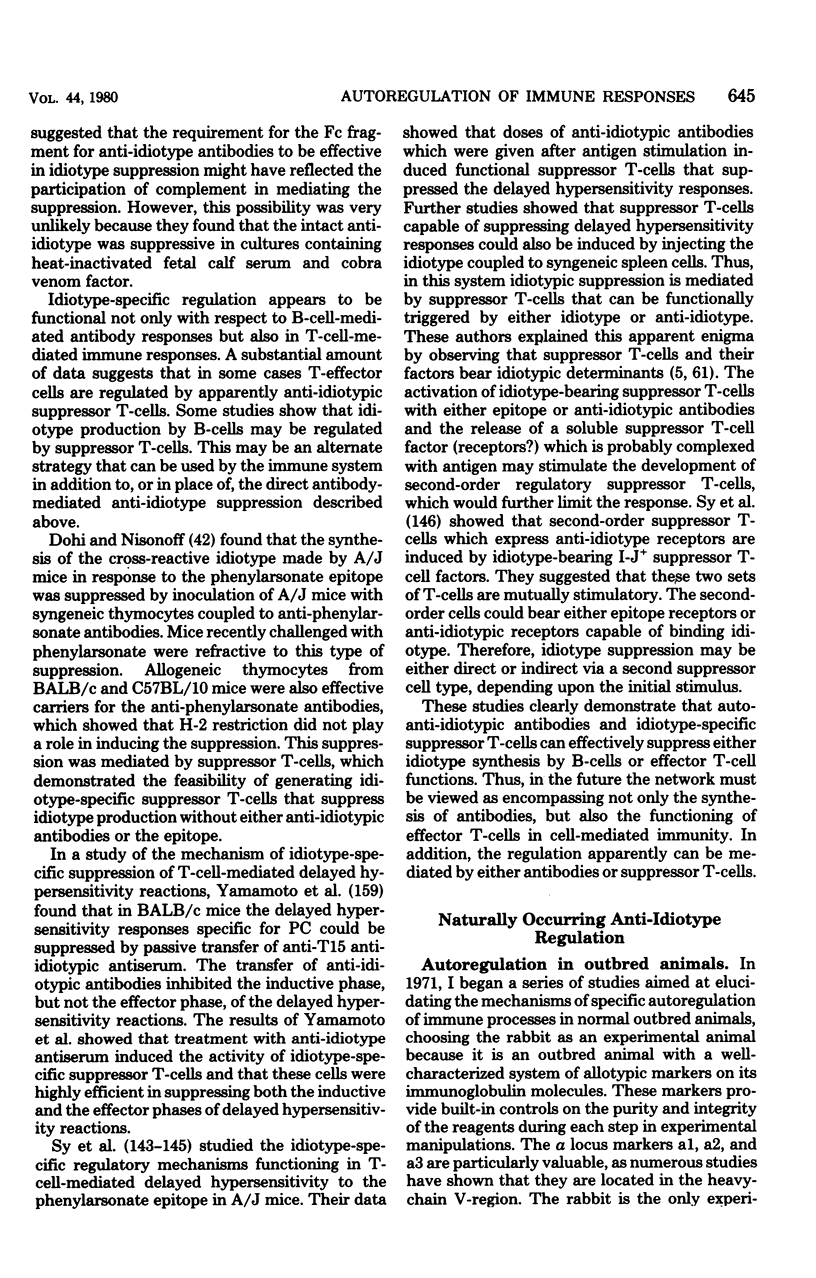
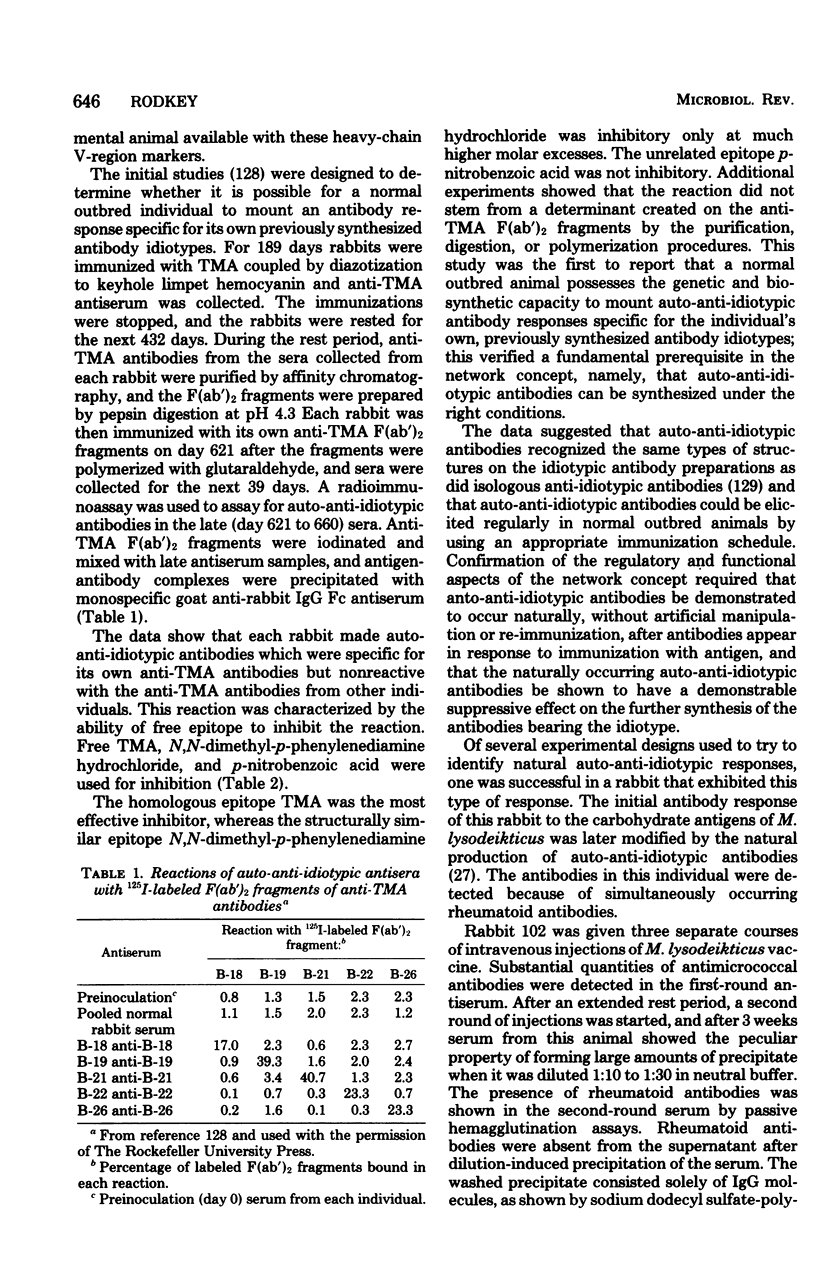
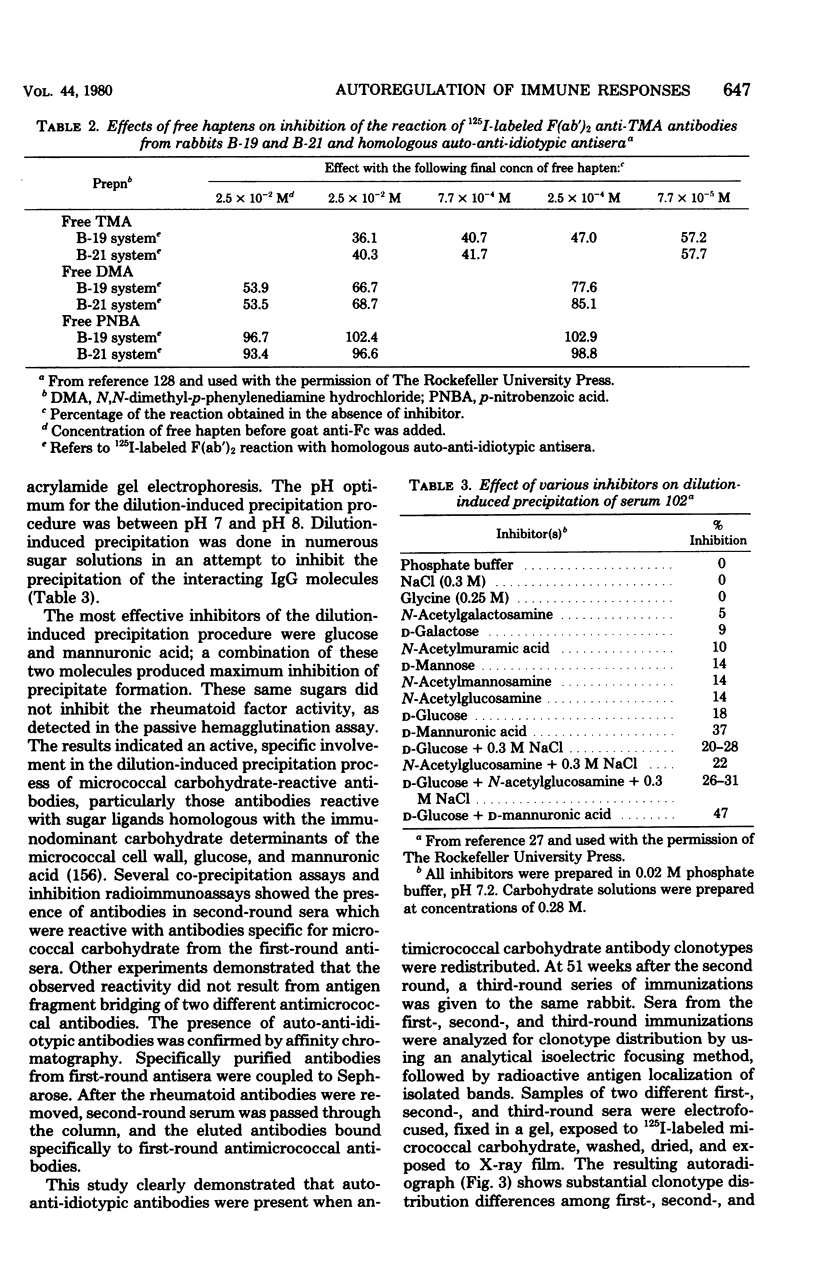
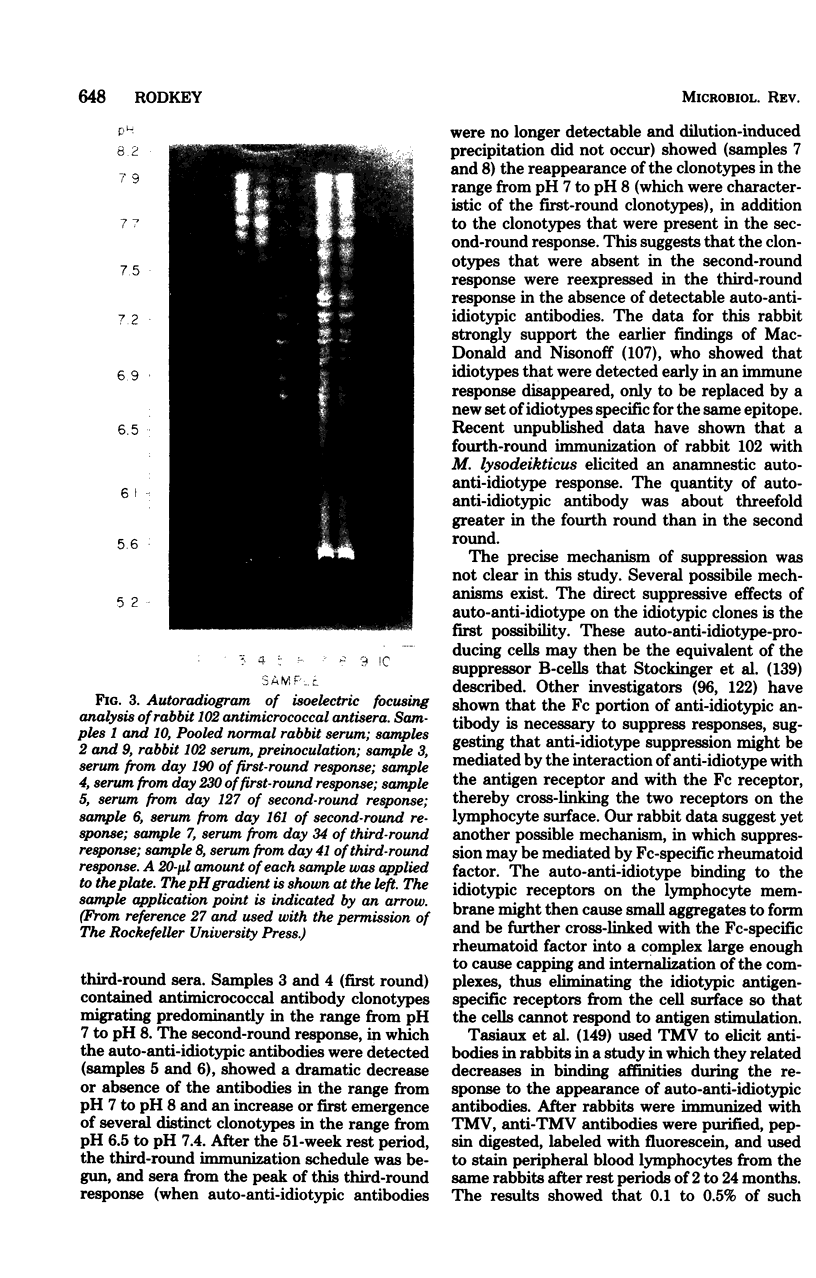
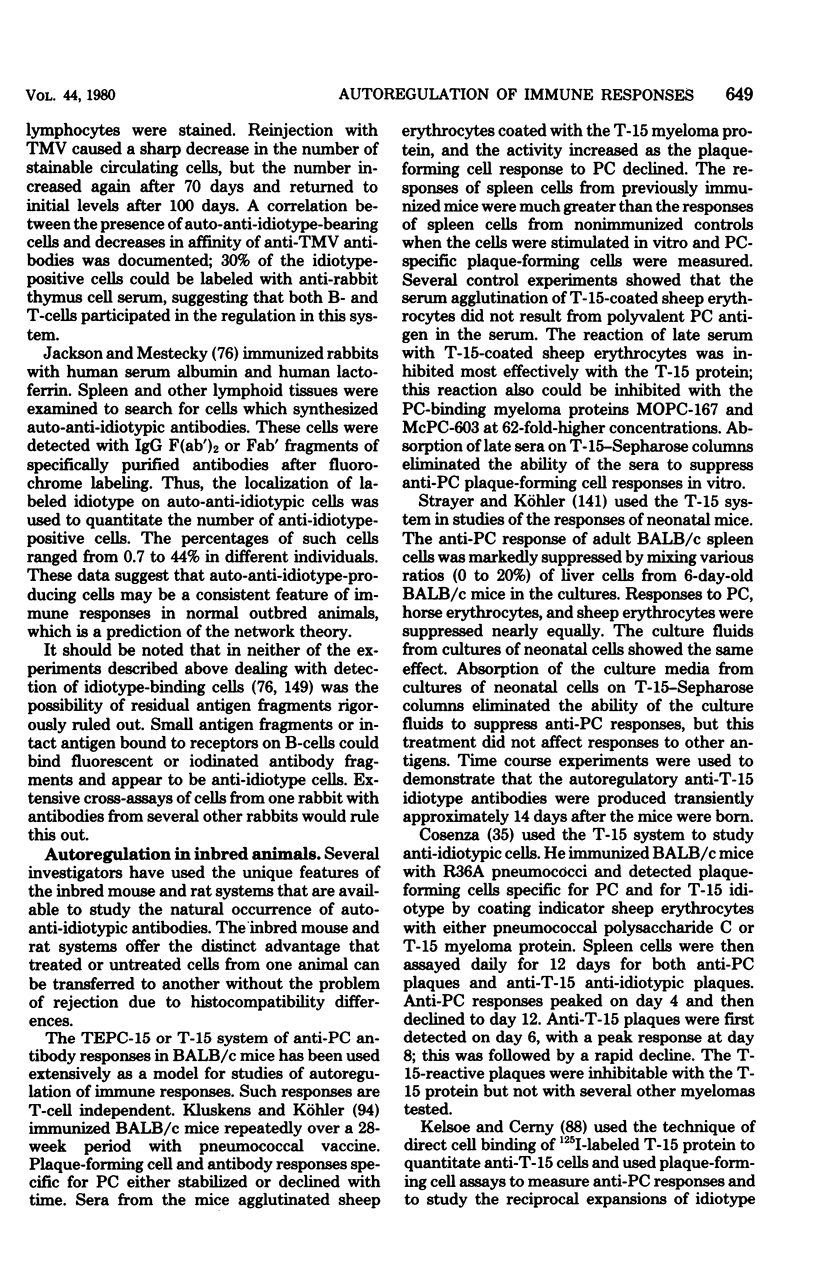
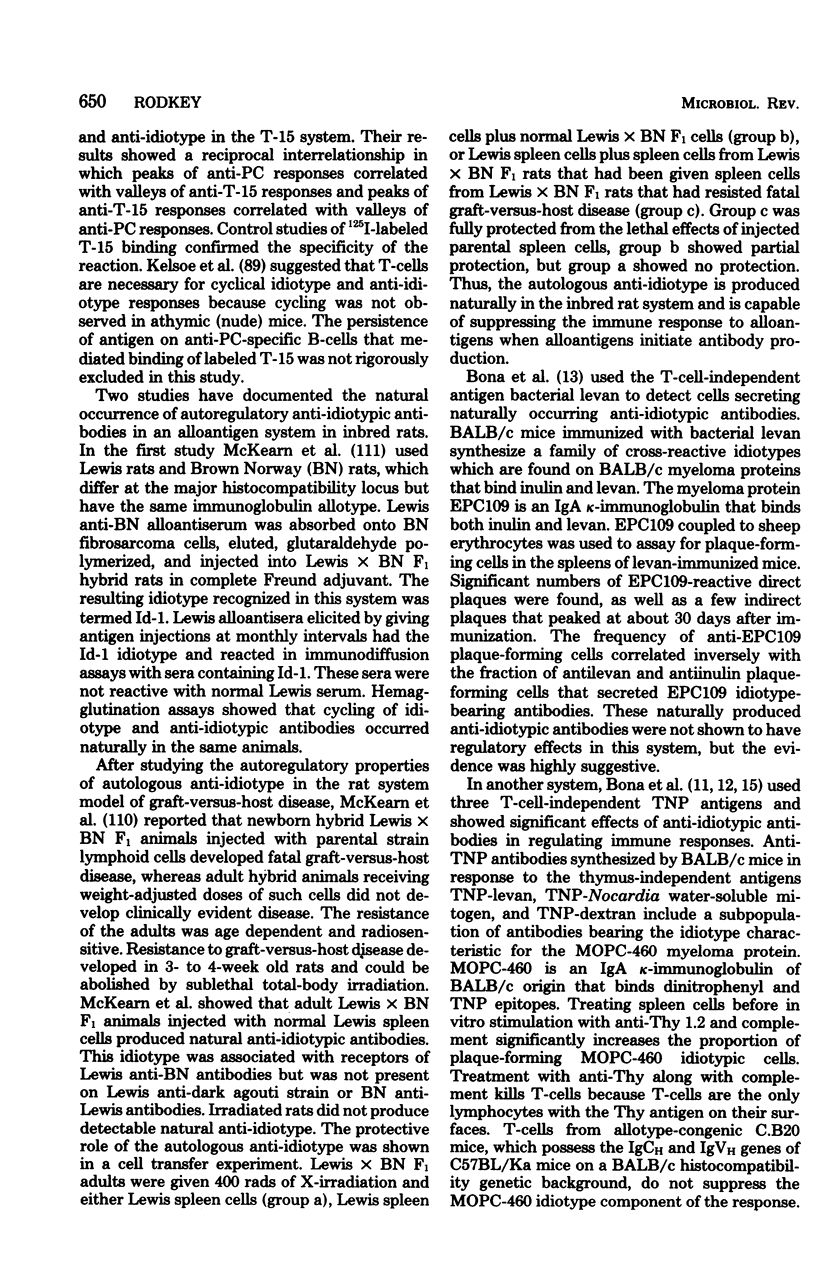
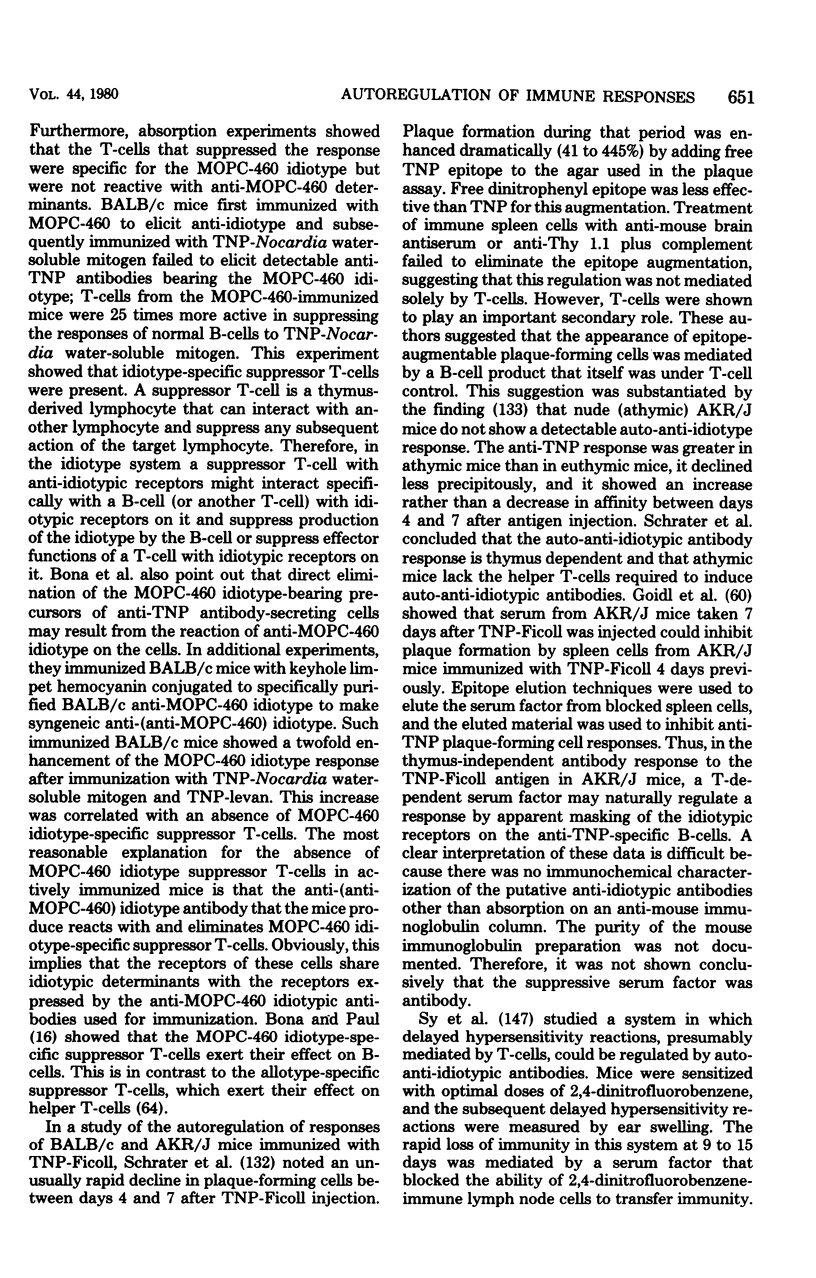
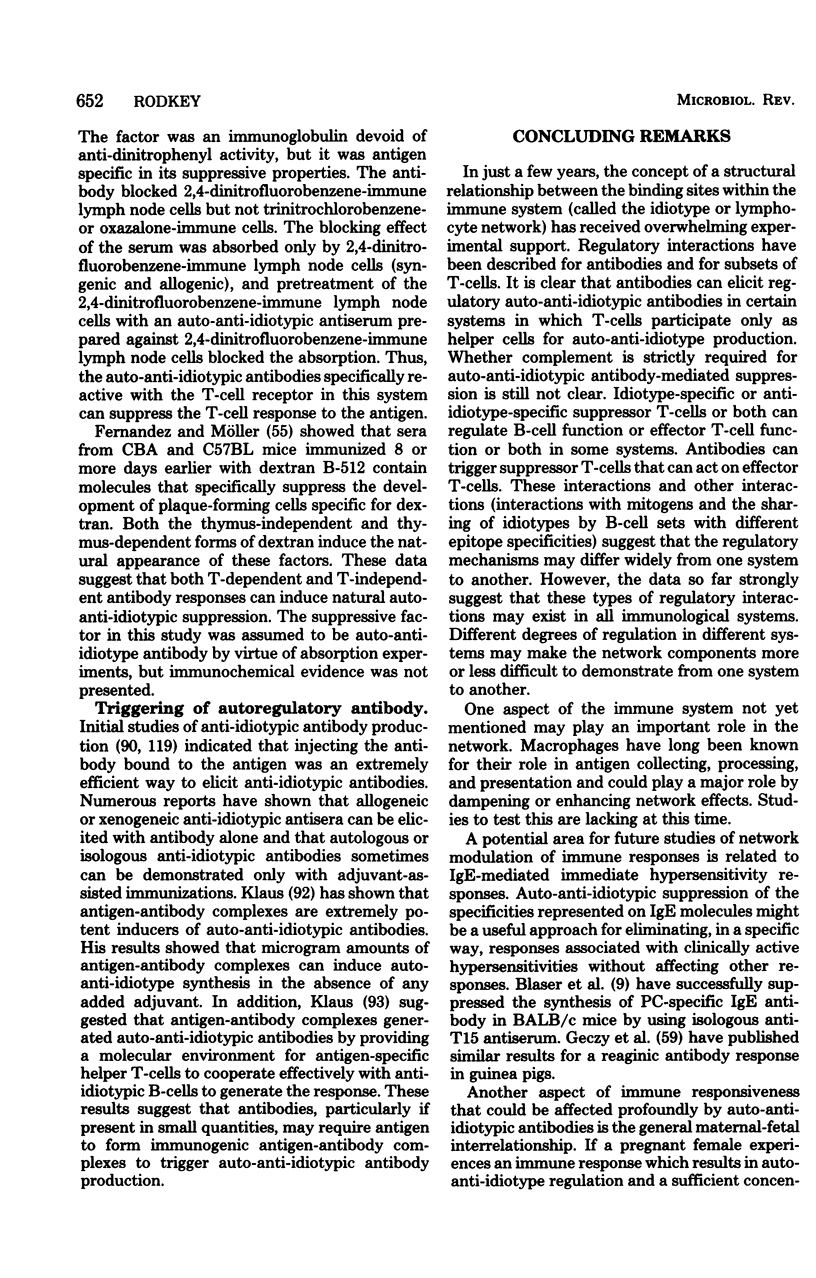
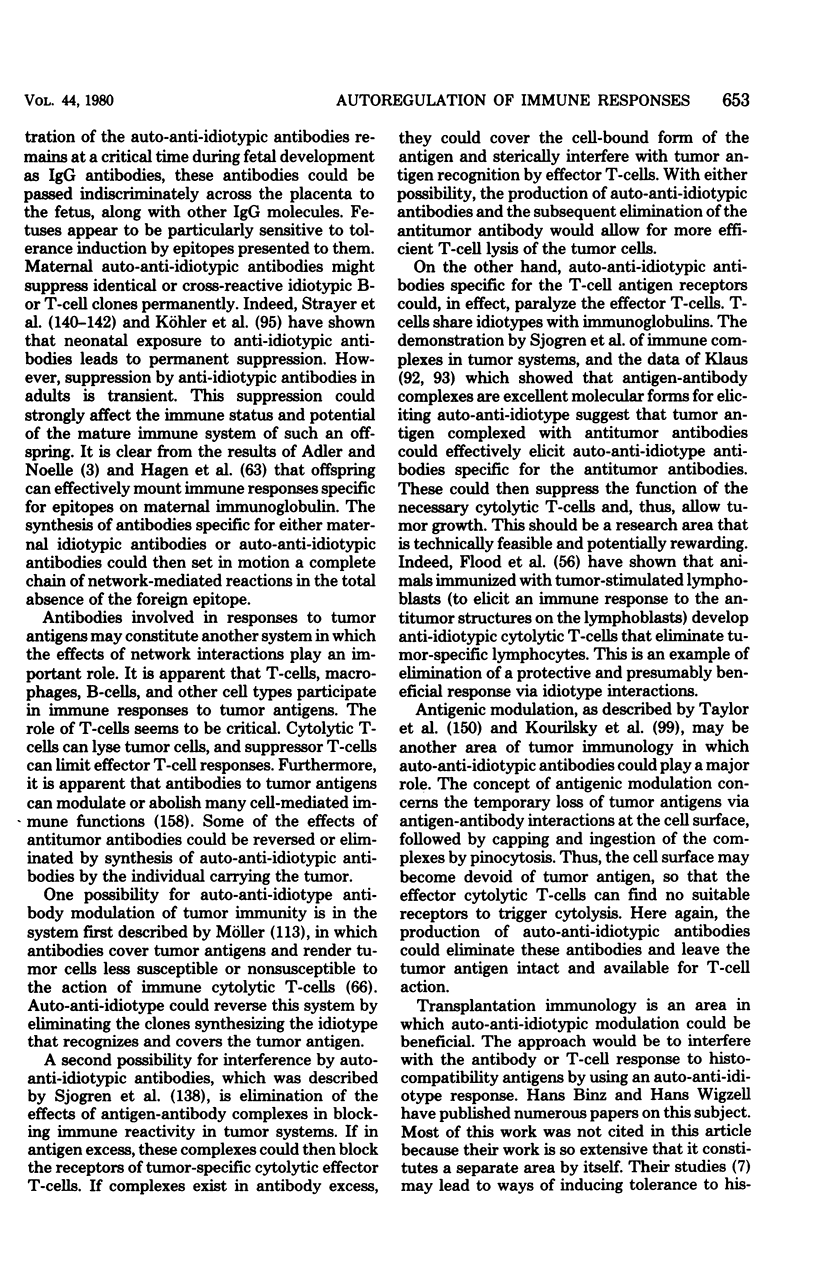
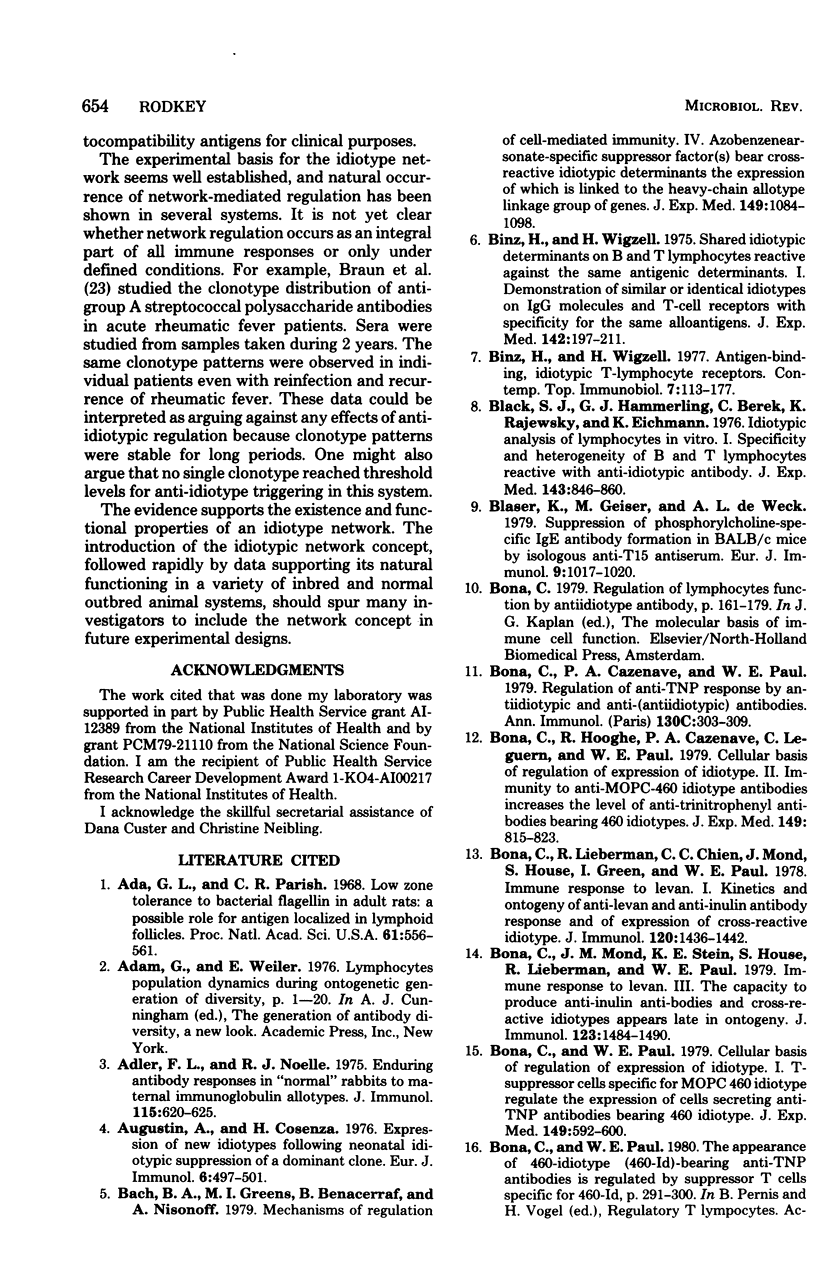
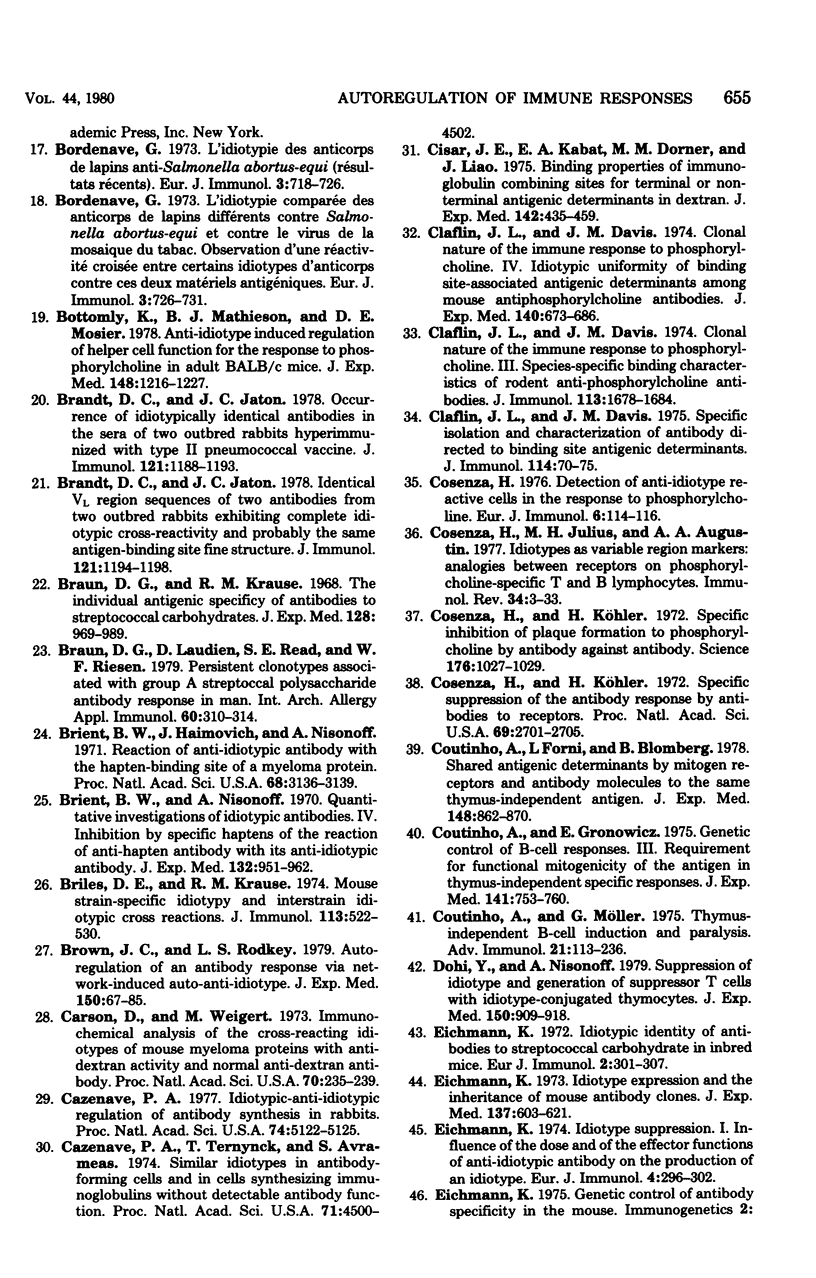
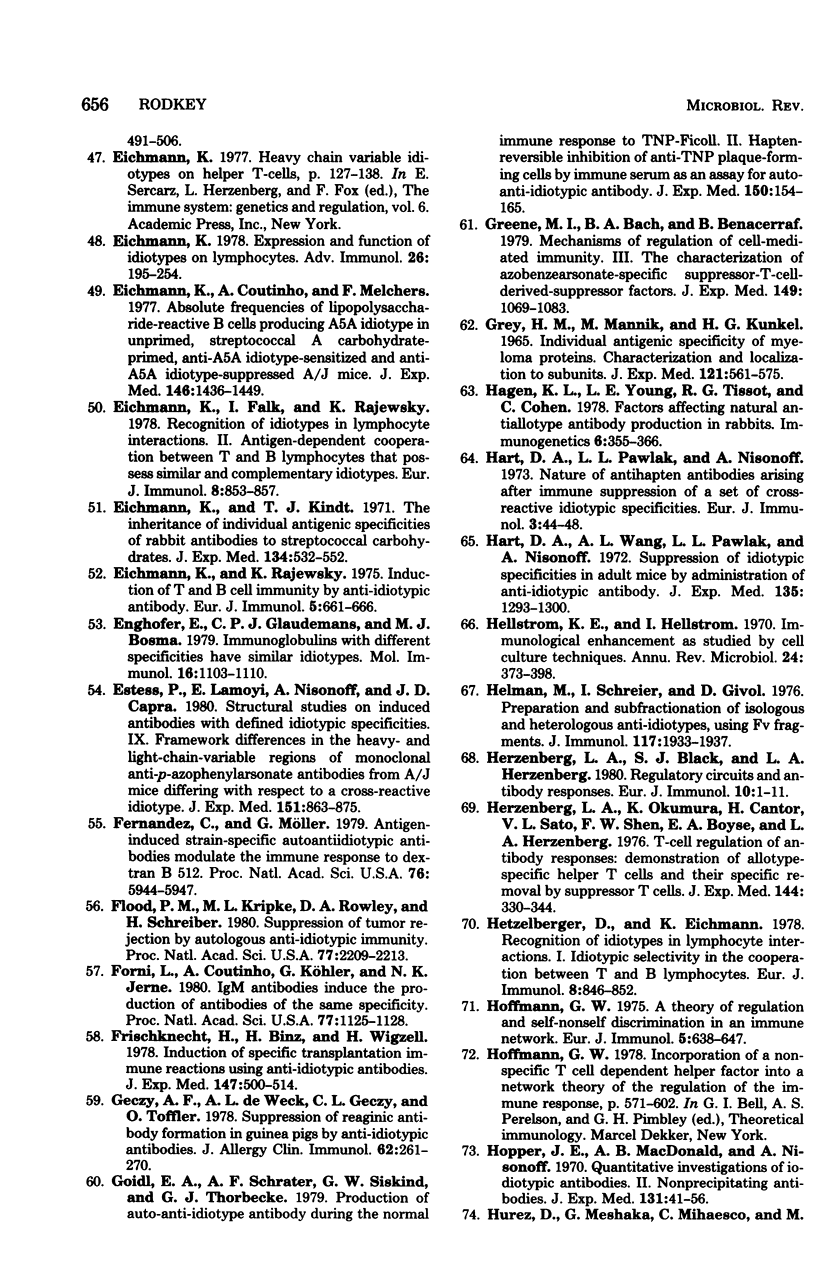
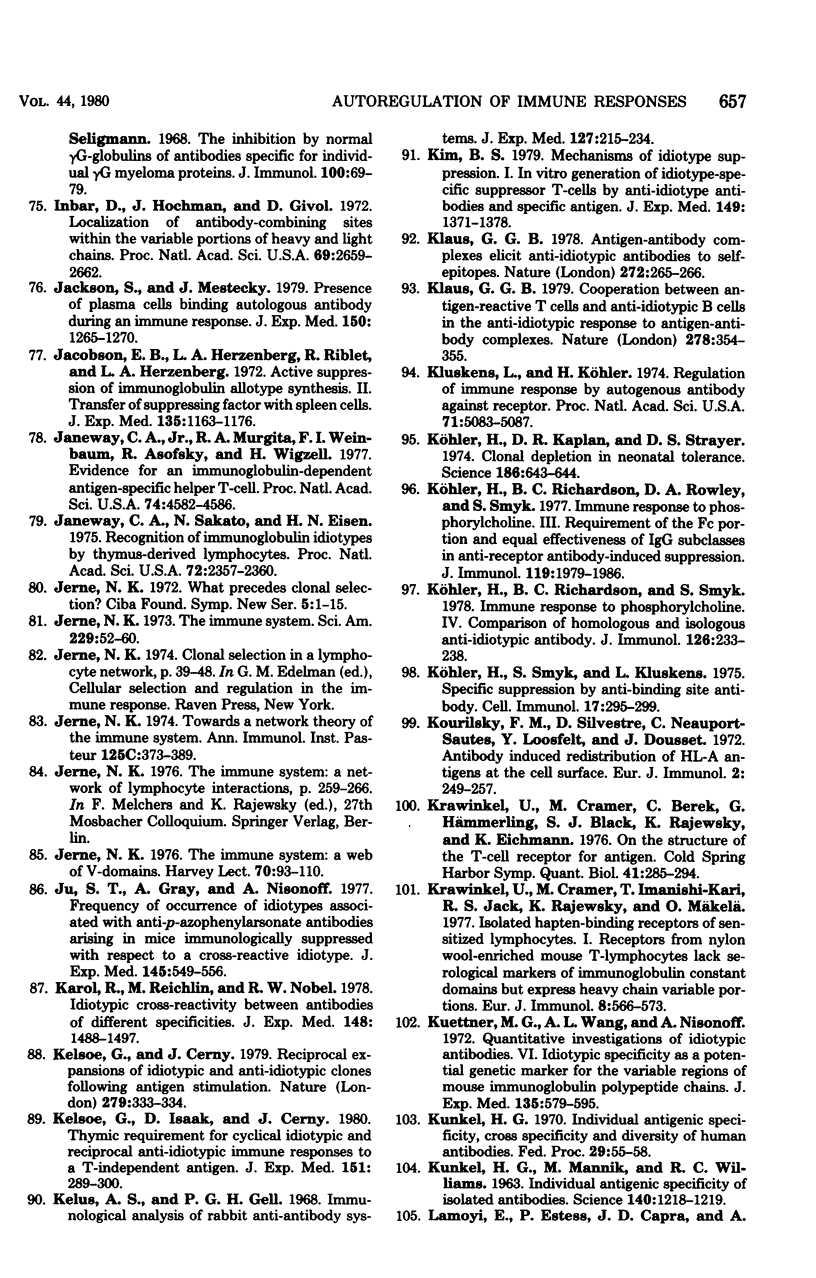
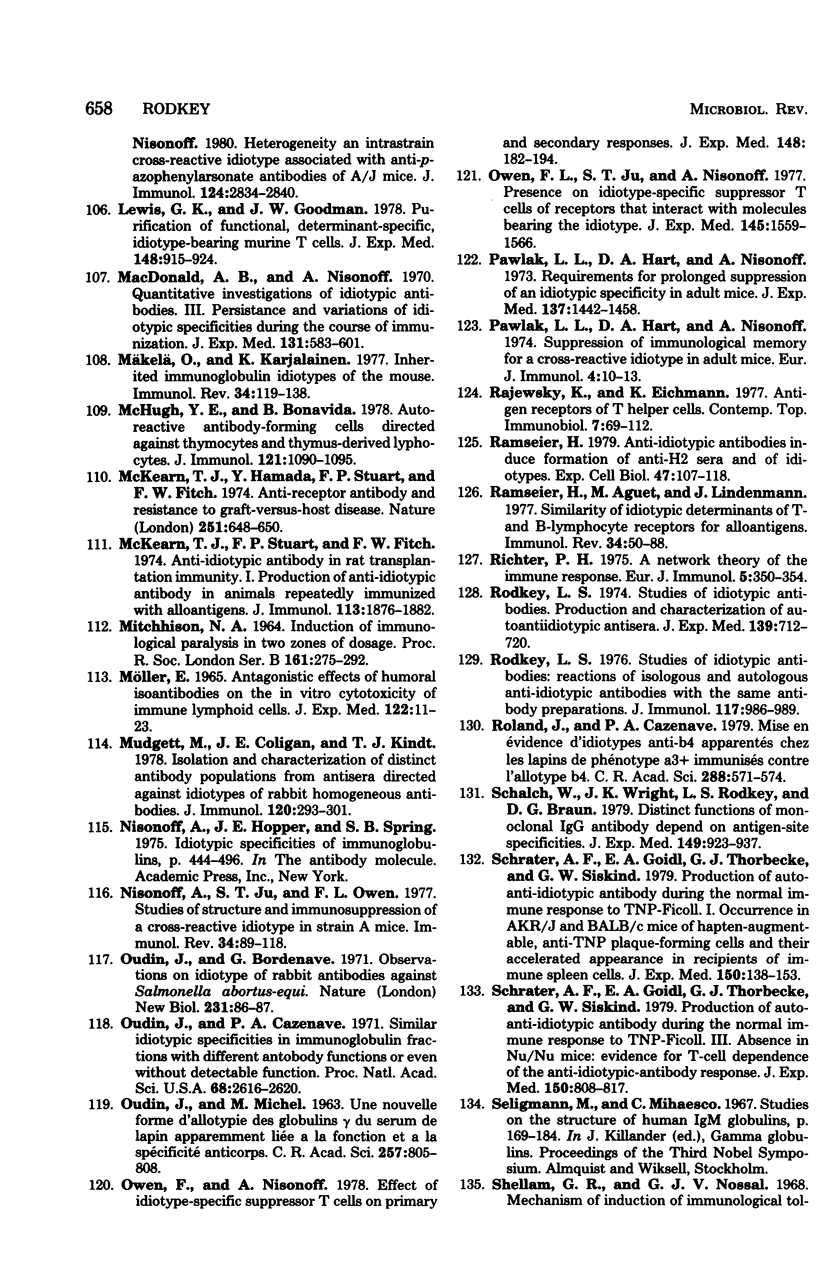
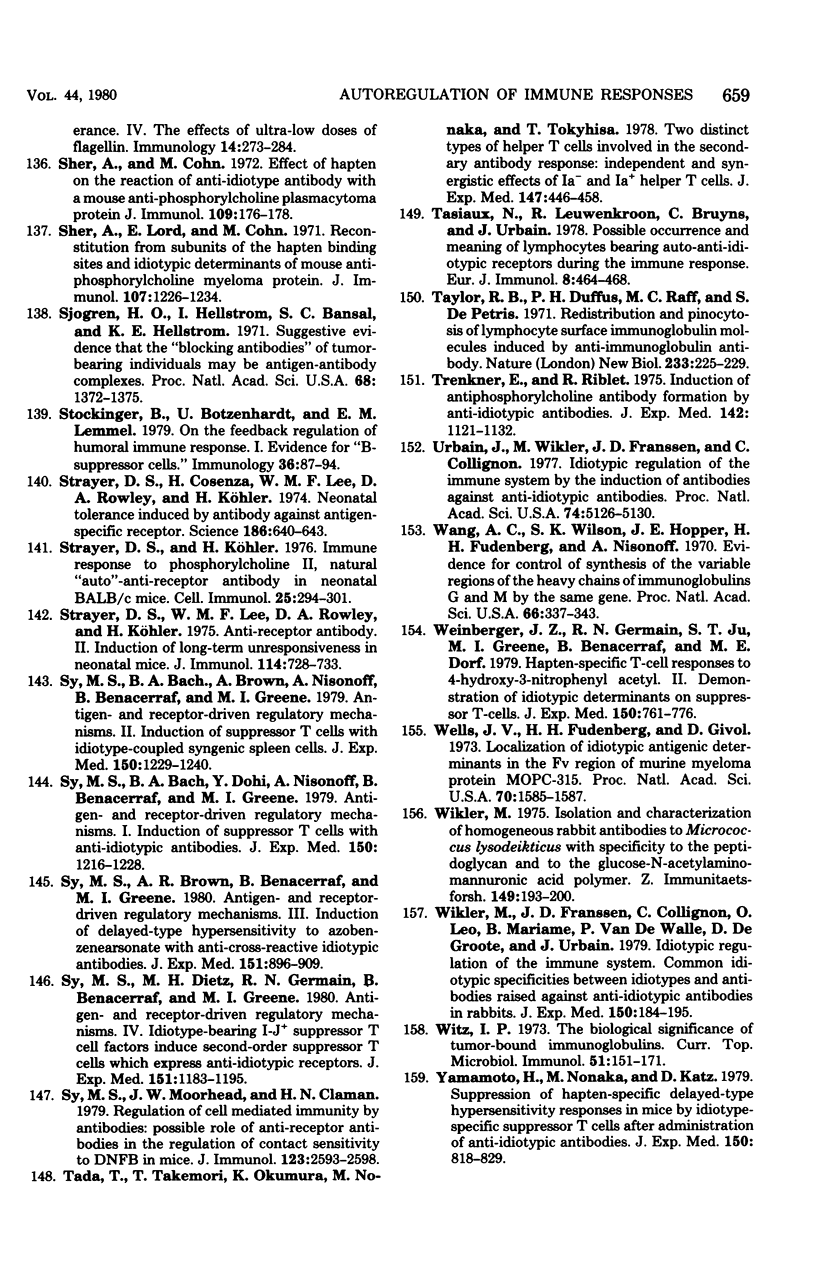
Images in this article
Selected References
These references are in PubMed. This may not be the complete list of references from this article.
- Ada G. L., Parish C. R. Low zone tolerance to bacterial flagellin in adult rats: a possible role for antigen localized in lymphoid follicles. Proc Natl Acad Sci U S A. 1968 Oct;61(2):556–561. doi: 10.1073/pnas.61.2.556. [DOI] [PMC free article] [PubMed] [Google Scholar]
- Adler F. L., Noelle R. J. Enduring antibody responses in "normal" rabbits to maternal immunoglobulin allotypes. J Immunol. 1975 Sep;115(3):620–625. [PubMed] [Google Scholar]
- Augustin A., Cosenza H. Expression of new idiotypes following neonatal idiotypic suppression of a dominant clone. Eur J Immunol. 1976 Jul;6(7):497–501. doi: 10.1002/eji.1830060710. [DOI] [PubMed] [Google Scholar]
- Bach B. A., Greene M. I., Benacerraf B., Nisonoff A. Mechanisms of regulation of cell-mediated immunity. IV. Azobenzenearsonate-specific suppressor factor(s) bear cross-reactive idiotypic determinants the expression of which is linked to the heavy-chain allotype linkage group of genes. J Exp Med. 1979 May 1;149(5):1084–1098. doi: 10.1084/jem.149.5.1084. [DOI] [PMC free article] [PubMed] [Google Scholar]
- Binz H., Wigzell H. Antigen-binding, idiotypic T-lymphocyte receptors. Contemp Top Immunobiol. 1977;7:113–177. doi: 10.1007/978-1-4684-3054-7_4. [DOI] [PubMed] [Google Scholar]
- Binz H., Wigzell H. Shared idiotypic determinants on B and T lymphocytes reactive against the same antigenic determinants. I. Demonstration of similar or identical idiotypes on IgG molecules and T-cell receptors with specificity for the same alloantigens. J Exp Med. 1975 Jul 1;142(1):197–211. doi: 10.1084/jem.142.1.197. [DOI] [PMC free article] [PubMed] [Google Scholar]
- Black S. J., Hämmerling G. J., Berek C., Rajewsky K., Eichmann K. Idiotypic analysis of lymphocytes in vitro. I. Specificity and heterogeneity of B and T lymphocytes reactive with anti-idiotypic antibody. J Exp Med. 1976 Apr 1;143(4):846–860. doi: 10.1084/jem.143.4.846. [DOI] [PMC free article] [PubMed] [Google Scholar]
- Blaser K., Geiser M., de Weck A. L. Suppression of phosphorylcholine-specific IgE antibody formation in BALB/c mice by isologous anti-T 15 antiserum. Eur J Immunol. 1979 Dec;9(12):1017–1020. doi: 10.1002/eji.1830091218. [DOI] [PubMed] [Google Scholar]
- Bona C., Cazenave P. A., Paul W. E. Regulation of anti-TNP response by antiidiotypic and anti-(antiidiotypic) antibodies. Ann Immunol (Paris) 1979 Mar-Apr;130(2):303–309. [PubMed] [Google Scholar]
- Bona C., Hooghe R., Cazenave P. A., Leguérn C., Paul W. E. Cellular basis of regulation of expression of idiotype. II. Immunity to anti-MOPC-460 idiotype antibodies increases the level of anti-trinitrophenyl antibodies bearing 460 idiotypes. J Exp Med. 1979 Apr 1;149(4):815–823. doi: 10.1084/jem.149.4.815. [DOI] [PMC free article] [PubMed] [Google Scholar]
- Bona C., Lieberman R., Chien C. C., Mond J., House S., Green I., Paul W. E. Immune response to levan. I. Kinetics and ontogeny of anti-levan and anti-inulin antibody response and of expression of cross-reactive idiotype. J Immunol. 1978 Apr;120(4):1436–1442. [PubMed] [Google Scholar]
- Bona C., Mond J. J., Stein K. E., House S., Lieberman R., Paul W. E. Immune response to levan. III. The capacity to produce anti-inulin antibodies and cross-reactive idiotypes appears late in ontogeny. J Immunol. 1979 Oct;123(4):1484–1490. [PubMed] [Google Scholar]
- Bona C., Paul W. E. Cellular basis of regulation of expression of idiotype. I. T-suppressor cells specific for MOPC 460 idiotype regulate the expression of cells secreting anti-TNP antibodies bearing 460 idiotype. J Exp Med. 1979 Mar 1;149(3):592–600. doi: 10.1084/jem.149.3.592. [DOI] [PMC free article] [PubMed] [Google Scholar]
- Bordenave G. L'idiotypie comparée des anticorps de lapins différents contre Salmonella abortus-equi et contre le virus de la mosaïque du tabac. Observation d'une réactivité croisée entre certains idiotypes d'anticorps contre ces deux matériels antigéniques. Eur J Immunol. 1973 Nov;3(11):726–731. doi: 10.1002/eji.1830031114. [DOI] [PubMed] [Google Scholar]
- Bordenave G. L'idiotypie des anticorps de lapins anti-Salmonella abortus-equi (résultats récents. Eur J Immunol. 1973 Nov;3(11):718–726. doi: 10.1002/eji.1830031114. [DOI] [PubMed] [Google Scholar]
- Bottomly K., Mathieson B. J., Mosier D. E. Anti-idiotype induced regulation of helper cell function for the response to phosphorylcholine in adult BALB/c mice. J Exp Med. 1978 Nov 1;148(5):1216–1227. doi: 10.1084/jem.148.5.1216. [DOI] [PMC free article] [PubMed] [Google Scholar]
- Brandt D. C., Jaton J. C. Identical VL region sequences of two antibodies from two outbred rabbits exhibiting complete idiotypic cross-reactivity and probably the same antigen-binding site fine structure. J Immunol. 1978 Sep;121(3):1194–1198. [PubMed] [Google Scholar]
- Brandt D. C., Jaton J. C. Occurrence of idiotypically identical antibodies in the sera of two outbred rabbits hyperimmunized with type II pneumococcal vaccine. J Immunol. 1978 Sep;121(3):1188–1193. [PubMed] [Google Scholar]
- Braun D. G., Krause R. M. The individual antigenic specificity of antibodies to streptococcal carbohydrates. J Exp Med. 1968 Nov 1;128(5):969–989. doi: 10.1084/jem.128.5.969. [DOI] [PMC free article] [PubMed] [Google Scholar]
- Braun D. G., Laudien D., Read S. E., Riesen W. F. Persistent clonotypes associated with group A streptococcal polysaccharide antibody response in man. Int Arch Allergy Appl Immunol. 1979;60(3):310–314. doi: 10.1159/000232356. [DOI] [PubMed] [Google Scholar]
- Brient B. W., Haimovich J., Nisonoff A. Reaction of anti-idiotypic antibody with the hapten-binding site of a myeloma protein. Proc Natl Acad Sci U S A. 1971 Dec;68(12):3136–3139. doi: 10.1073/pnas.68.12.3136. [DOI] [PMC free article] [PubMed] [Google Scholar]
- Brient B. W., Nisonoff A. Quantitative investigations of idiotypic antibodies. IV. Inhibition by specific haptens of the reaction of anti-hapten antibody with its anti-idiotypic antibody. J Exp Med. 1970 Nov;132(5):951–962. doi: 10.1084/jem.132.5.951. [DOI] [PMC free article] [PubMed] [Google Scholar]
- Briles D. E., Krause R. M. Mouse strain-specific idiotypy and interstrain idiotypic cross-reactions. J Immunol. 1974 Aug;113(2):522–530. [PubMed] [Google Scholar]
- Brown J. C., Rodkey L. S. Autoregulation of an antibody response via network-induced auto-anti-idiotype. J Exp Med. 1979 Jul 1;150(1):67–85. doi: 10.1084/jem.150.1.67. [DOI] [PMC free article] [PubMed] [Google Scholar]
- Carson D., Weigert M. Immunochemical analysis of the cross-reacting idiotypes of mouse myeloma proteins with anti-dextran activity and normal anti-dextran antibody. Proc Natl Acad Sci U S A. 1973 Jan;70(1):235–239. doi: 10.1073/pnas.70.1.235. [DOI] [PMC free article] [PubMed] [Google Scholar]
- Cazenave P. A. Idiotypic-anti-idiotypic regulation of antibody synthesis in rabbits. Proc Natl Acad Sci U S A. 1977 Nov;74(11):5122–5125. doi: 10.1073/pnas.74.11.5122. [DOI] [PMC free article] [PubMed] [Google Scholar]
- Cazenave P. A., Ternynck T., Avrameas S. Similar idiotypes in antibody-forming cells and in cells synthesizing immunoglobulins without detectable antibody function. Proc Natl Acad Sci U S A. 1974 Nov;71(11):4500–4502. doi: 10.1073/pnas.71.11.4500. [DOI] [PMC free article] [PubMed] [Google Scholar]
- Cisar J., Kabat E. A., Dorner M. M., Liao J. Binding properties of immunoglobulin combining sites specific for terminal or nonterminal antigenic determinants in dextran. J Exp Med. 1975 Aug 1;142(2):435–459. doi: 10.1084/jem.142.2.435. [DOI] [PMC free article] [PubMed] [Google Scholar]
- Claflin J. L., Davie J. M. Clonal nature of the immune response to phosphorylcholine. III. Species-specific binding characteristics of rodent anti-phosphorylcholine antibodies. J Immunol. 1974 Dec;113(6):1678–1684. [PubMed] [Google Scholar]
- Claflin J. L., Davie J. M. Clonal nature of the immune response to phosphorylcholine. IV. Idiotypic uniformity of binding site-associated antigenic determinants among mouse antiphosphorylcholine antibodies. J Exp Med. 1974 Sep 1;140(3):673–686. doi: 10.1084/jem.140.3.673. [DOI] [PMC free article] [PubMed] [Google Scholar]
- Claflin J. L., Davie J. M. Specific isolation and characterization of antibody directed to binding site antigenic determinants. J Immunol. 1975 Jan;114(1 Pt 1):70–75. [PubMed] [Google Scholar]
- Cosenza H. Detection of anti-idiotype reactive cells in the response to phosphorylcholine. Eur J Immunol. 1976 Feb;6(2):114–116. doi: 10.1002/eji.1830060208. [DOI] [PubMed] [Google Scholar]
- Cosenza H., Julius M. H., Augustin A. A. Idiotypes as variable region markers: analogies between receptors on phosphorylcholine-specific T and B lymphocytes. Immunol Rev. 1977;34:3–33. doi: 10.1111/j.1600-065x.1977.tb00366.x. [DOI] [PubMed] [Google Scholar]
- Cosenza H., Köhler H. Specific inhibition of plaque formation to phosphorylcholine by antibody against antibody. Science. 1972 Jun 2;176(4038):1027–1029. doi: 10.1126/science.176.4038.1027. [DOI] [PubMed] [Google Scholar]
- Cosenza H., Köhler H. Specific suppression of the antibody response by antibodies to receptors. Proc Natl Acad Sci U S A. 1972 Sep;69(9):2701–2705. doi: 10.1073/pnas.69.9.2701. [DOI] [PMC free article] [PubMed] [Google Scholar]
- Coutinho A., Forni L., Blomberg B. Shared antigenic determinants by mitogen receptors and antibody molecules to the same thymus-independent antigen. J Exp Med. 1978 Oct 1;148(4):862–870. doi: 10.1084/jem.148.4.862. [DOI] [PMC free article] [PubMed] [Google Scholar]
- Coutinho A., Gronowicz E. Genetical control of B-cell responses. III. Requirement for functional mitogenicity of the antigen in thymus-independent specific responses. J Exp Med. 1975 Apr 1;141(4):753–760. [PMC free article] [PubMed] [Google Scholar]
- Coutinho A., Möller G. Thymus-independent B-cell induction and paralysis. Adv Immunol. 1975;21:113–236. doi: 10.1016/s0065-2776(08)60220-5. [DOI] [PubMed] [Google Scholar]
- Dohi Y., Nisonoff A. Suppression of idiotype and generation of suppressor T cells with idiotype-conjugated thymocytes. J Exp Med. 1979 Oct 1;150(4):909–918. doi: 10.1084/jem.150.4.909. [DOI] [PMC free article] [PubMed] [Google Scholar]
- Eichmann K., Coutinho A., Melchers F. Absolute frequencies of lipopolysaccharide-reactive B cells producing A5A idiotype in unprimed, streptococcal A carbohydrate-primed, anti-A5A idiotype-sensitized and anti-A5A idiotype-suppressed A/J mice. J Exp Med. 1977 Nov 1;146(5):1436–1449. doi: 10.1084/jem.146.5.1436. [DOI] [PMC free article] [PubMed] [Google Scholar]
- Eichmann K. Expression and function of idiotypes of lymphocytes. Adv Immunol. 1978;26:195–254. doi: 10.1016/s0065-2776(08)60231-x. [DOI] [PubMed] [Google Scholar]
- Eichmann K., Falk I., Rajewsky K. Recognition of idiotypes in lymphocyte interactions. II. Antigen-independent cooperation between T and B lymphocytes that possess similar and complementary idiotypes. Eur J Immunol. 1978 Dec;8(12):853–857. doi: 10.1002/eji.1830081206. [DOI] [PubMed] [Google Scholar]
- Eichmann K. Idiotype expression and the inheritance of mouse antibody clones. J Exp Med. 1973 Mar 1;137(3):603–621. doi: 10.1084/jem.137.3.603. [DOI] [PMC free article] [PubMed] [Google Scholar]
- Eichmann K. Idiotype suppression. I. Influence of the dose and of the effector functions of anti-idiotypic antibody on the production of an idiotype. Eur J Immunol. 1974 Apr;4(4):296–302. doi: 10.1002/eji.1830040413. [DOI] [PubMed] [Google Scholar]
- Eichmann K. Idiotypic identity of antibodies to streptococcal carbohydrate in inbred mice. Eur J Immunol. 1972 Aug;2(4):301–307. doi: 10.1002/eji.1830020402. [DOI] [PubMed] [Google Scholar]
- Eichmann K., Kindt T. J. The inheritance of individual antigenic specificities of rabbit antibodies to streptococcal carbohydrates. J Exp Med. 1971 Aug 1;134(2):532–552. doi: 10.1084/jem.134.2.532. [DOI] [PMC free article] [PubMed] [Google Scholar]
- Eichmann K., Rajewsky K. Induction of T and B cell immunity by anti-idiotypic antibody. Eur J Immunol. 1975 Oct;5(10):661–666. doi: 10.1002/eji.1830051002. [DOI] [PubMed] [Google Scholar]
- Enghofer E., Glaudemans C. P., Bosma M. J. Immunoglobulins with different specificities have similar idiotypes. Mol Immunol. 1979 Dec;16(12):1103–1110. doi: 10.1016/0161-5890(79)90044-0. [DOI] [PubMed] [Google Scholar]
- Estess P., Lamoyi E., Nisonoff A., Capra J. D. Structural studies on induced antibodies with defined idiotypic specificities. IX. Framework differences in the heavy- and light-chain-variable regions of monoclonal anti-p-azophenylarsonate antibodies from A/J mice differing with respect to a cross-reactive idiotype. J Exp Med. 1980 Apr 1;151(4):863–875. doi: 10.1084/jem.151.4.863. [DOI] [PMC free article] [PubMed] [Google Scholar]
- Fernandez C., Möller G. Antigen-induced strain-specific autoantiidiotypic antibodies modulate the immune response to dextran B 512. Proc Natl Acad Sci U S A. 1979 Nov;76(11):5944–5947. doi: 10.1073/pnas.76.11.5944. [DOI] [PMC free article] [PubMed] [Google Scholar]
- Flood P. M., Kripke M. L., Rowley D. A., Schreiber H. Suppression of tumor rejection by autologous anti-idiotypic immunity. Proc Natl Acad Sci U S A. 1980 Apr;77(4):2209–2213. doi: 10.1073/pnas.77.4.2209. [DOI] [PMC free article] [PubMed] [Google Scholar]
- Forni L., Coutinho A., Köhler G., Jerne N. K. IgM antibodies induce the production of antibodies of the same specificity. Proc Natl Acad Sci U S A. 1980 Feb;77(2):1125–1128. doi: 10.1073/pnas.77.2.1125. [DOI] [PMC free article] [PubMed] [Google Scholar]
- Frischknecht H., Binz H., Wigzell H. Induction of specific transplantation immune reactions using anti-idiotypic antibodies. J Exp Med. 1978 Feb 1;147(2):500–514. doi: 10.1084/jem.147.2.500. [DOI] [PMC free article] [PubMed] [Google Scholar]
- GREY H. M., MANNIK M., KUNKEL H. G. INDIVIDUAL ANTIGENIC SPECIFICITY OF MYELOMA PROTEINS. CHARACTERISTICS AND LOCALIZATION TO SUBUNITS. J Exp Med. 1965 Apr 1;121:561–575. doi: 10.1084/jem.121.4.561. [DOI] [PMC free article] [PubMed] [Google Scholar]
- Geczy A. F., de Weck A. L., Geczy C. L., Toffler O. Suppression of reaginic antibody formation in guinea pigs by anti-idiotypic antibodies. J Allergy Clin Immunol. 1978 Nov;62(5):261–270. doi: 10.1016/0091-6749(78)90156-2. [DOI] [PubMed] [Google Scholar]
- Goidl E. A., Schrater A. F., Siskind G. W., Thorbecke G. J. Production of auto-anti-idiotypic antibody during the normal immune response to TNP-Ficoll. II. Hapten-reversible inhibition of anti-TNP plaque-forming cells by immune serum as an assay for auto-anti-idiotypic antibody. J Exp Med. 1979 Jul 1;150(1):154–165. doi: 10.1084/jem.150.1.154. [DOI] [PMC free article] [PubMed] [Google Scholar]
- Greene M. I., Bach B. A., Benacerraf B. Mechanisms of regulation of cell-mediated immunity. III. The characterization of azobenzenearsonate-specific suppressor T-cell-derived-suppressor factors. J Exp Med. 1979 May 1;149(5):1069–1083. doi: 10.1084/jem.149.5.1069. [DOI] [PMC free article] [PubMed] [Google Scholar]
- Hart D. A., Pawlak L. L., Nisonoff A. Nature of anti-hapten antibodies arising after immune suppression of a set of cross-raactive idiotypic specificities. Eur J Immunol. 1973 Jan;3(1):44–48. doi: 10.1002/eji.1830030110. [DOI] [PubMed] [Google Scholar]
- Hart D. A., Wang A. L., Pawlak L. L., Nisonoff A. Suppression of idiotypic specificities in adult mice by administration of antiidiotypic antibody. J Exp Med. 1972 Jun 1;135(6):1293–1300. doi: 10.1084/jem.135.6.1293. [DOI] [PMC free article] [PubMed] [Google Scholar]
- Hellström K. E., Hellström I. Immunological enhancement as studied by cell culture techniques. Annu Rev Microbiol. 1970;24:373–398. doi: 10.1146/annurev.mi.24.100170.002105. [DOI] [PubMed] [Google Scholar]
- Helman M., Shreier I., Givol D. Preparation and subfractionation of isologous and heterologous anti-idiotypes, using FV fragments. J Immunol. 1976 Nov;117(5 PT2):1933–1937. [PubMed] [Google Scholar]
- Herzenberg L. A., Black S. J., Herzenberg L. A. Regulatory circuits and antibody responses. Eur J Immunol. 1980 Jan;10(1):1–11. doi: 10.1002/eji.1830100102. [DOI] [PubMed] [Google Scholar]
- Herzenberg L. A., Okumura K., Cantor H., Sato V. L., Shen F. W., Boyse E. A., Herzenberg L. A. T-cell regulation of antibody responses: demonstration of allotype-specific helper T cells and their specific removal by suppressor T cells. J Exp Med. 1976 Aug 1;144(2):330–344. doi: 10.1084/jem.144.2.330. [DOI] [PMC free article] [PubMed] [Google Scholar]
- Hetzelberger D., Eichmann K. Recognition of idiotypes in lymphocyte interactions. I. Idiotypic selectivity in the cooperation between T and B lymphocytes. Eur J Immunol. 1978 Dec;8(12):846–852. doi: 10.1002/eji.1830081205. [DOI] [PubMed] [Google Scholar]
- Hoffmann G. W. A theory of regulation and self-nonself discrimination in an immune network. Eur J Immunol. 1975 Sep;5(9):638–647. doi: 10.1002/eji.1830050912. [DOI] [PubMed] [Google Scholar]
- Hopper J. E., MacDonald A. B., Nisonoff A. Quantitative investigations of idiotypic antibodies. II. Nonprecipitating antibodies. J Exp Med. 1970 Jan 1;131(1):41–56. doi: 10.1084/jem.131.1.41. [DOI] [PMC free article] [PubMed] [Google Scholar]
- Hurez D., Meshaka G., Mihaesco C., Seligmann M. The inhibition by normal gamma-G-globulins of antibodies specific for individual gamma-G-myeloma proteins. J Immunol. 1968 Jan;100(1):69–79. [PubMed] [Google Scholar]
- Inbar D., Hochman J., Givol D. Localization of antibody-combining sites within the variable portions of heavy and light chains. Proc Natl Acad Sci U S A. 1972 Sep;69(9):2659–2662. doi: 10.1073/pnas.69.9.2659. [DOI] [PMC free article] [PubMed] [Google Scholar]
- Jackson S., Mestecky J. Presence of plasma cells binding autologous antibody during an immune response. J Exp Med. 1979 Nov 1;150(5):1265–1270. doi: 10.1084/jem.150.5.1265. [DOI] [PMC free article] [PubMed] [Google Scholar]
- Jacobson E. B., Herzenberg L. A., Riblet R., Herzenberg L. A. Active suppression of immunoglobulin allotype synthesis. II. Transfer of suppressing factor with spleen cells. J Exp Med. 1972 May 1;135(5):1163–1176. doi: 10.1084/jem.135.5.1163. [DOI] [PMC free article] [PubMed] [Google Scholar]
- Janeway C. A., Jr, Murgita R. A., Weinbaum F. I., Asofsky R., Wigzell H. Evidence for an immunoglobulin-dependent antigen-specific helper T cell. Proc Natl Acad Sci U S A. 1977 Oct;74(10):4582–4586. doi: 10.1073/pnas.74.10.4582. [DOI] [PMC free article] [PubMed] [Google Scholar]
- Janeway C. A., Jr, Sakato N., Eisen H. N. Recognition of immunoglobulin idiotypes by thymus-derived lymphocytes. Proc Natl Acad Sci U S A. 1975 Jun;72(6):2357–2360. doi: 10.1073/pnas.72.6.2357. [DOI] [PMC free article] [PubMed] [Google Scholar]
- Jerne N. K. Clonal selection in a lymphocyte network. Soc Gen Physiol Ser. 1974;29:39–48. [PubMed] [Google Scholar]
- Jerne N. K. The immune system. Sci Am. 1973 Jul;229(1):52–60. doi: 10.1038/scientificamerican0773-52. [DOI] [PubMed] [Google Scholar]
- Jerne N. K. The immune system: a web of V-domains. Harvey Lect. 1974 1975;70(SERIES):93–110. [PubMed] [Google Scholar]
- Jerne N. K. Towards a network theory of the immune system. Ann Immunol (Paris) 1974 Jan;125C(1-2):373–389. [PubMed] [Google Scholar]
- Ju S., Gray A., Nisonoff A. Frequency of occurrence of idiotypes associated with anti-p-azophenylarsonate antibodies arising in mice immunologically suppressed with respect to a cross-reactive idiotype. J Exp Med. 1977 Mar 1;145(3):540–556. doi: 10.1084/jem.145.3.540. [DOI] [PMC free article] [PubMed] [Google Scholar]
- Karol R., Reichlin M., Noble R. W. Idiotypic cross-reactivity between antibodies of different specificities. J Exp Med. 1978 Dec 1;148(6):1488–1497. doi: 10.1084/jem.148.6.1488. [DOI] [PMC free article] [PubMed] [Google Scholar]
- Kelsoe G., Cerny J. Reciprocal expansions of idiotypic and anti-idiotypic clones following antigen stimulation. Nature. 1979 May 24;279(5711):333–334. doi: 10.1038/279333a0. [DOI] [PubMed] [Google Scholar]
- Kelsoe G., Isaak D., Cerny J. Thymic requirement for cyclical idiotypic and reciprocal anti-idiotypic immune responses to a T-independent antigen. J Exp Med. 1980 Feb 1;151(2):289–300. doi: 10.1084/jem.151.2.289. [DOI] [PMC free article] [PubMed] [Google Scholar]
- Kelus A. S., Gell P. G. Immunological analysis of rabbit anti-antibody systems. J Exp Med. 1968 Jan 1;127(1):215–234. doi: 10.1084/jem.127.1.215. [DOI] [PMC free article] [PubMed] [Google Scholar]
- Kim B. S. Mechanisms of idiotype suppression. I. In vitro generation of idiotype-specific suppressor T cells by anti-idiotype antibodies and specific antigen. J Exp Med. 1979 Jun 1;149(6):1371–1378. doi: 10.1084/jem.149.6.1371. [DOI] [PMC free article] [PubMed] [Google Scholar]
- Klaus G. G. Antigen-antibody complexes elicit anti-idiotypic antibodies to self-idiotopes. Nature. 1978 Mar 16;272(5650):265–266. doi: 10.1038/272265a0. [DOI] [PubMed] [Google Scholar]
- Klaus G. G. Cooperation between antigen-reactive T cells and anti-idiotypic B cells in the anti-idiotypic response to antigen-antibody complexes. Nature. 1979 Mar 22;278(5702):354–355. doi: 10.1038/278354a0. [DOI] [PubMed] [Google Scholar]
- Kluskens L., Köhler H. Regulation of immune response by autogenous antibody against receptor. Proc Natl Acad Sci U S A. 1974 Dec;71(12):5083–5087. doi: 10.1073/pnas.71.12.5083. [DOI] [PMC free article] [PubMed] [Google Scholar]
- Kourilsky F. M., Silvestre D., Neauport-Sautes C., Loosfelt Y., Dausset J. Antibody-induced redistribution of HL-A antigens at the cell surface. Eur J Immunol. 1972 Jun;2(3):249–257. doi: 10.1002/eji.1830020311. [DOI] [PubMed] [Google Scholar]
- Krawinkel U., Cramer M., Berek C., Hämmerling G., Black S. J., Rajewsky K., Eichmann K. On the structure of the T-cell receptor for antigen. Cold Spring Harb Symp Quant Biol. 1977;41(Pt 1):285–294. doi: 10.1101/sqb.1977.041.01.034. [DOI] [PubMed] [Google Scholar]
- Krawinkel U., Cramer M., Imanishi-Kari T., Jack R. S., Rajewsky K., Mäkelä O. Isolated hapten-binding receptors of sensitized lymphocytes. I. Receptors from nylon wool-enriched mouse T lymphocytes lack serological markers of immunoglobulin constant domains but express heavy chain variable portions. Eur J Immunol. 1977 Aug;7(8):566–573. doi: 10.1002/eji.1830070814. [DOI] [PubMed] [Google Scholar]
- Kuettner M. G., Wang A. L., Nisonoff A. Quantitative investigations of idiotypic antibodies. VI. Idiotypic specificity as a potential genetic marker for the variable regions of mouse immunoglobulin polypeptide chains. J Exp Med. 1972 Mar 1;135(3):579–595. doi: 10.1084/jem.135.3.579. [DOI] [PMC free article] [PubMed] [Google Scholar]
- Kunkel H. G. Experimental approaches tohomogenous antibody populations. iIndividual antigenic specificity, cross specificity and diversity of human antibodies. Fed Proc. 1970 Jan-Feb;29(1):55–58. [PubMed] [Google Scholar]
- Kunkel H. G., Mannik M., Williams R. C. Individual Antigenic Specificity of Isolated Antibodies. Science. 1963 Jun 14;140(3572):1218–1219. doi: 10.1126/science.140.3572.1218. [DOI] [PubMed] [Google Scholar]
- Köhler H., Kaplan D. R., Strayer D. S. Clonal depletion in neonatal tolerance. Science. 1974 Nov 15;186(4164):643–644. doi: 10.1126/science.186.4164.643. [DOI] [PubMed] [Google Scholar]
- Köhler H., Richardson B. C., Rowley D. A., Smyk S. Immune response to phosphorylcholine. III. Requirement of the Fc portion and equal effectiveness of IgG subclasses in anti-receptor antibody-induced suppression. J Immunol. 1977 Dec;119(6):1979–1986. [PubMed] [Google Scholar]
- Köhler H., Richardson R. C., Smyk S. Immune response to phosphorylcholine. I.V. Comparison of homologous and isologous anti-idiotypic antibody. J Immunol. 1978 Jan;120(1):233–238. [PubMed] [Google Scholar]
- Köhler H., Smyk S., Kluskens L. Specific suppression by anti-binding site antibody. Cell Immunol. 1975 May;17(1):295–299. doi: 10.1016/s0008-8749(75)80029-3. [DOI] [PubMed] [Google Scholar]
- Lamoyi E., Estess P., Capra J. D., Nisonoff A. Heterogeneity of an intrastrain cross-reactive idiotype associated with anti-p-azophenylarsonate antibodies of A/J mice. J Immunol. 1980 Jun;124(6):2834–2840. [PubMed] [Google Scholar]
- Lewis G. K., Goodman J. W. Purification of functional, determinant-specific, idiotype-bearing murine T cells. J Exp Med. 1978 Oct 1;148(4):915–924. doi: 10.1084/jem.148.4.915. [DOI] [PMC free article] [PubMed] [Google Scholar]
- MITCHISON N. A. INDUCTION OF IMMUNOLOGICAL PARALYSIS IN TWO ZONES OF DOSAGE. Proc R Soc Lond B Biol Sci. 1964 Dec 15;161:275–292. doi: 10.1098/rspb.1964.0093. [DOI] [PubMed] [Google Scholar]
- MOELLER E. ANTAGONISTIC EFFECTS OF HUMORAL ISOANTIBODIES ON THE IN VITRO CYTOTOXICITY OF IMMUNE LYMPHOID CELLS. J Exp Med. 1965 Jul 1;122:11–23. doi: 10.1084/jem.122.1.11. [DOI] [PMC free article] [PubMed] [Google Scholar]
- MacDonald A. B., Nisonoff A. Quantitative investigations of idiotypic antibodies. 3. Persistence and variations of idiotypic specificities during the course of immunization. J Exp Med. 1970 Mar 1;131(3):583–601. doi: 10.1084/jem.131.3.583. [DOI] [PMC free article] [PubMed] [Google Scholar]
- McHugh Y. E., Bonavida B. Autoreactive antibody-forming cells directed against thymocytes and thymus-derived lymphocytes. J Immunol. 1978 Sep;121(3):1090–1095. [PubMed] [Google Scholar]
- McKearn T. J., Hamada Y., Stuart F. P., Fitch F. W. Anti-receptor antibody and resistance to graft-versus-host disease. Nature. 1974 Oct 18;251(5476):648–650. doi: 10.1038/251648a0. [DOI] [PubMed] [Google Scholar]
- McKearn T. J., Stuart F. P., Fitch F. W. Anti-idiotypic antibody in rat transplantation immunity. I. Production of anti-idiotypic antibody in animals repeatedly immunized with alloantigens. J Immunol. 1974 Dec;113(6):1876–1882. [PubMed] [Google Scholar]
- Mudgett M., Coligan J. E., Kindt T. J. Isolation and characterization of distinct antibody populations from antisera directed against idiotypes of rabbit homogeneous antibodies. J Immunol. 1978 Jan;120(1):293–301. [PubMed] [Google Scholar]
- Mäkelä O., Karjalainen K. Inherited immunoglobulin idiotypes of the mouse. Immunol Rev. 1977;34:119–138. doi: 10.1111/j.1600-065x.1977.tb00370.x. [DOI] [PubMed] [Google Scholar]
- Nisonoff A., Ju S. T., Owen F. L. Studies of structure and immunosuppression of cross-reactive idiotype in strain A mice. Immunol Rev. 1977;34:89–118. doi: 10.1111/j.1600-065x.1977.tb00369.x. [DOI] [PubMed] [Google Scholar]
- OUDIN J., MICHEL M. [A new allotype form of rabbit serum gamma-globulins, apparently associated with antibody function and specificity]. C R Hebd Seances Acad Sci. 1963 Jul 17;257:805–808. [PubMed] [Google Scholar]
- Oudin J., Bordenave G. Observations on idiotypy of rabbit antibodies against Salmonella abortus-equi. Nat New Biol. 1971 May 19;231(20):86–87. doi: 10.1038/newbio231086a0. [DOI] [PubMed] [Google Scholar]
- Oudin J., Cazenave P. A. Similar idiotypic specificities in immunoglobulin fractions with different antibody functions or even without detectable antibody function. Proc Natl Acad Sci U S A. 1971 Oct;68(10):2616–2620. doi: 10.1073/pnas.68.10.2616. [DOI] [PMC free article] [PubMed] [Google Scholar]
- Owen F. L., Ju S. T., Nisonoff A. Presence on idiotype-specific suppressor T cells of receptors that interact with molecules bearing the idiotype. J Exp Med. 1977 Jun 1;145(6):1559–1566. doi: 10.1084/jem.145.6.1559. [DOI] [PMC free article] [PubMed] [Google Scholar]
- Owen F. L., Nisonoff A. Effect of idiotype-specific suppressor T cells on primary and secondary responses. J Exp Med. 1978 Jul 1;148(1):182–194. doi: 10.1084/jem.148.1.182. [DOI] [PMC free article] [PubMed] [Google Scholar]
- Pawlak L. L., Hart D. A., Nisonoff A. Requirements for prolonged suppression of an idiotypic specificity in adult mice. J Exp Med. 1973 Jun 1;137(6):1442–1458. doi: 10.1084/jem.137.6.1442. [DOI] [PMC free article] [PubMed] [Google Scholar]
- Pawlak L. L., Hart D. A., Nisonoff A. Suppression of immunological memory for a cross-reactive idiotype in adult mice. Eur J Immunol. 1974 Jan;4(1):10–13. doi: 10.1002/eji.1830040104. [DOI] [PubMed] [Google Scholar]
- Rajewsky K., Eichmann K. Antigen receptors of T helper cells. Contemp Top Immunobiol. 1977;7:69–112. doi: 10.1007/978-1-4684-3054-7_3. [DOI] [PubMed] [Google Scholar]
- Ramseier H., Aguet M., Lindenmann J. Similarity of idiotypic determinants of T-and B-lymphocyte receptors for alloantigens. Immunol Rev. 1977;34:50–88. doi: 10.1111/j.1600-065x.1977.tb00368.x. [DOI] [PubMed] [Google Scholar]
- Ramseier H. Anti-idiotypic antibodies induce formation of anti-H-2 sera and of idiotypes. Exp Cell Biol. 1979;47(2):107–118. doi: 10.1159/000162927. [DOI] [PubMed] [Google Scholar]
- Richter P. H. A network theory of the immune system. Eur J Immunol. 1975 May;5(5):350–354. doi: 10.1002/eji.1830050511. [DOI] [PubMed] [Google Scholar]
- Rodkey L. S. Studies of idiotypic antibodies. Production and characterization of autoantiidiotypic antisera. J Exp Med. 1974 Mar 1;139(3):712–720. doi: 10.1084/jem.139.3.712. [DOI] [PMC free article] [PubMed] [Google Scholar]
- Rodkey L. S. Studies of idiotypic antibodies: reactions of isologous and autologous anti-idiotypic antibodies with the same antibody preparations. J Immunol. 1976 Sep;117(3):986–989. [PubMed] [Google Scholar]
- Roland J., Cazenave P. A. Mise en évidence d'idiotypes anti-b4 apparentés chez les lapins de phénotype a 3+ immunisés contre l'allotype b4. C R Seances Acad Sci D. 1979 Feb 5;288(5):571–574. [PubMed] [Google Scholar]
- Schalch W., Wright J. K., Rodkey L. S., Braun D. G. Distinct functions of monoclonal IgG antibody depend on antigen-site specificities. J Exp Med. 1979 Apr 1;149(4):923–937. doi: 10.1084/jem.149.4.923. [DOI] [PMC free article] [PubMed] [Google Scholar]
- Schrater A. F., Goidl E. A., Thorbecke G. J., Siskind G. W. Production of auto-anti-idiotypic antibody during the normal immune response to TNP-ficoll. I. Occurrence in AKR/J and BALB/c mice of hapten-augmentable, anti-TNP plaque-forming cells and their accelerated appearance in recipients of immune spleen cells. J Exp Med. 1979 Jul 1;150(1):138–153. doi: 10.1084/jem.150.1.138. [DOI] [PMC free article] [PubMed] [Google Scholar]
- Schrater A. F., Goidl E. A., Thorbecke G. J., Siskind G. W. Production of auto-anti-idiotypic antibody during the normal immune response to TNP-ficoll. III. Absence in nu/nu mice: evidence for T-cell dependence of the anti-idiotypic-antibody response. J Exp Med. 1979 Oct 1;150(4):808–817. doi: 10.1084/jem.150.4.808. [DOI] [PMC free article] [PubMed] [Google Scholar]
- Shellam G. R., Nossal G. J. Mechanism of induction of immunological tolerance. IV. The effects of ultra-low doses of flagellin. Immunology. 1968 Feb;14(2):273–284. [PMC free article] [PubMed] [Google Scholar]
- Sher A., Cohn M. Effect of haptens on the reaction of anti-idiotype antibody with a mouse anti-phosphorylcholine plasmacytoma protein. J Immunol. 1972 Jul;109(1):176–178. [PubMed] [Google Scholar]
- Sher A., Lord E., Cohn M. Reconstitution from subunits of the hapten binding sites and idiotypic determinants of mouse anti-phosphorylcholine myeloma proteins. J Immunol. 1971 Nov;107(5):1226–1234. [PubMed] [Google Scholar]
- Sjögren H. O., Hellström I., Bansal S. C., Hellström K. E. Suggestive evidence that the "blocking antibodies" of tumor-bearing individuals may be antigen--antibody complexes. Proc Natl Acad Sci U S A. 1971 Jun;68(6):1372–1375. doi: 10.1073/pnas.68.6.1372. [DOI] [PMC free article] [PubMed] [Google Scholar]
- Stockinger B., Botzenhardt U., Lemmel E. M. On the feedback regulation of humoral immune response. I. Evidence for 'B suppressor cells'. Immunology. 1979 Jan;36(1):87–94. [PMC free article] [PubMed] [Google Scholar]
- Strayer D. S., Cosenza H., Lee W. M., Rowley D. A., Köhler H. Neonatal tolerance induced by antibody against antigen-specific receptor. Science. 1974 Nov 15;186(4164):640–643. doi: 10.1126/science.186.4164.640. [DOI] [PubMed] [Google Scholar]
- Strayer D. S., Kohler H. Immune response to phosphorylcholine II, natural "auto"-anti-receptor antibody in neonatal Balb/c mice. Cell Immunol. 1976 Aug;25(2):294–301. doi: 10.1016/0008-8749(76)90119-2. [DOI] [PubMed] [Google Scholar]
- Strayer D. S., Lee W. M., Rowley D. A., Köhler H. Anti-receptor antibody. II. Induction of long-term unresponsiveness in neonatal mice. J Immunol. 1975 Feb;114(2 Pt 2):728–733. [PubMed] [Google Scholar]
- Sy M. S., Bach B. A., Brown A., Nisonoff A., Benacerraf B., Greene M. I. Antigen- and receptor-driven regulatory mechanisms. II. Induction of suppressor T cells with idiotype-coupled syngeneic spleen cells. J Exp Med. 1979 Nov 1;150(5):1229–1240. doi: 10.1084/jem.150.5.1229. [DOI] [PMC free article] [PubMed] [Google Scholar]
- Sy M. S., Bach B. A., Dohi Y., Nisonoff A., Benacerraf B., Greene M. I. Antigen- and receptor-driven regulatory mechanisms. I. Induction of suppressor T cells with anti-idiotypic antibodies. J Exp Med. 1979 Nov 1;150(5):1216–1228. doi: 10.1084/jem.150.5.1216. [DOI] [PMC free article] [PubMed] [Google Scholar]
- Sy M. S., Brown A. R., Benacerraf B., Greene M. I. Antigen- and receptor-driven regulatory mechanisms. III. Induction of delayed type hypersensitivity to azobenzenearsonate with anti-cross-reactive idiotypic antibodies. J Exp Med. 1980 Apr 1;151(4):896–909. doi: 10.1084/jem.151.4.896. [DOI] [PMC free article] [PubMed] [Google Scholar]
- Sy M. S., Dietz M. H., Germain R. N., Benacerraf B., Greene M. I. Antigen- and receptor-driven regulatory mechanisms. IV. Idiotype-bearing I-J+ suppressor T cell factors induce second-order suppressor T cells which express anti-idiotypic receptors. J Exp Med. 1980 May 1;151(5):1183–1195. doi: 10.1084/jem.151.5.1183. [DOI] [PMC free article] [PubMed] [Google Scholar]
- Sy M. S., Moorhead J. W., Claman H. N. Regulation of cell mediated immunity by antibodies: possible role of anti-receptor antibodies in the regulation of contact sensitivity to DNFB in mice. J Immunol. 1979 Dec;123(6):2593–2598. [PubMed] [Google Scholar]
- Tada T., Takemori T., Okumura K., Nonaka M., Tokuhisa T. Two distinct types of helper T cells involved in the secondary antibody response: independent and synergistic effects of Ia- and Ia+ helper T cells. J Exp Med. 1978 Feb 1;147(2):446–458. doi: 10.1084/jem.147.2.446. [DOI] [PMC free article] [PubMed] [Google Scholar]
- Tasiaux N., Leuwenkroon R., Bruyns C., Urbain J. Possible occurrence and meaning of lymphocytes bearing autoanti-idiotypic receptors during the immune response. Eur J Immunol. 1978 Jul;8(7):464–468. doi: 10.1002/eji.1830080704. [DOI] [PubMed] [Google Scholar]
- Trenkner E., Riblet R. Induction of antiphosphorylcholine antibody formation by anti-idiotypic antibodies. J Exp Med. 1975 Nov 1;142(5):1121–1132. doi: 10.1084/jem.142.5.1121. [DOI] [PMC free article] [PubMed] [Google Scholar]
- Urbain J., Wikler M., Franssen J. D., Collignon C. Idiotypic regulation of the immune system by the induction of antibodies against anti-idiotypic antibodies. Proc Natl Acad Sci U S A. 1977 Nov;74(11):5126–5130. doi: 10.1073/pnas.74.11.5126. [DOI] [PMC free article] [PubMed] [Google Scholar]
- Wang A. C., Wilson K. S., Hopper J. E., Fudenberg H. H., Nisonoff A. Evidence for control of synthesis of the varible regions of the heavy chains of immunoglobulins G and M by the same gene. Proc Natl Acad Sci U S A. 1970 Jun;66(2):337–343. doi: 10.1073/pnas.66.2.337. [DOI] [PMC free article] [PubMed] [Google Scholar]
- Weinberger J. Z., Germain R. N., Ju S. T., Greene M. I., Benacerraf B., Dorf M. E. Hapten-specific T-cell responses to 4-hydroxy-3-nitrophenyl acetyl. II. Demonstration of idiotypic determinants on suppressor T cells. J Exp Med. 1979 Oct 1;150(4):761–776. doi: 10.1084/jem.150.4.761. [DOI] [PMC free article] [PubMed] [Google Scholar]
- Wells J. V., Fudenberg H. H., Givol D. Localization of idiotypic antigenic determinants in the Fv region of murine myeloma protein MOPC-315. Proc Natl Acad Sci U S A. 1973 May;70(5):1585–1587. doi: 10.1073/pnas.70.5.1585. [DOI] [PMC free article] [PubMed] [Google Scholar]
- Wikler M. Isolation and characterization of homogenous rabbit antibodies to Micrococcus lysodeikticus with specificity to the peptidoglycan and to the glucose-N-acetylaminomannuronic acid polymer. Z Immunitatsforsch Exp Klin Immunol. 1975 Jul;149(2-4):193–200. [PubMed] [Google Scholar]
- Winkler M., Franssen J. D., Collignon C., Leo O., Mariamé B., van de Walle P., de Groote D., Urbain J. Idiotypic regulation of the immune system. Common idiotypic specificities between idiotypes and antibodies raised against anti-idiotypic antibodies in rabbits. J Exp Med. 1979 Jul 1;150(1):184–195. doi: 10.1084/jem.150.1.184. [DOI] [PMC free article] [PubMed] [Google Scholar]
- Witz I. P. The biological significance of tumor-bound immunoglobulins. Curr Top Microbiol Immunol. 1973;61:151–171. doi: 10.1007/978-3-642-65531-9_4. [DOI] [PubMed] [Google Scholar]
- Yamamoto H., Nonaka M., Katz D. H. Suppression of hapten-specific delayed-type hypersensitivity responses in mice by idiotype-specific suppressor T cells after administration of anti-idiotypic antibodies. J Exp Med. 1979 Oct 1;150(4):818–829. doi: 10.1084/jem.150.4.818. [DOI] [PMC free article] [PubMed] [Google Scholar]



